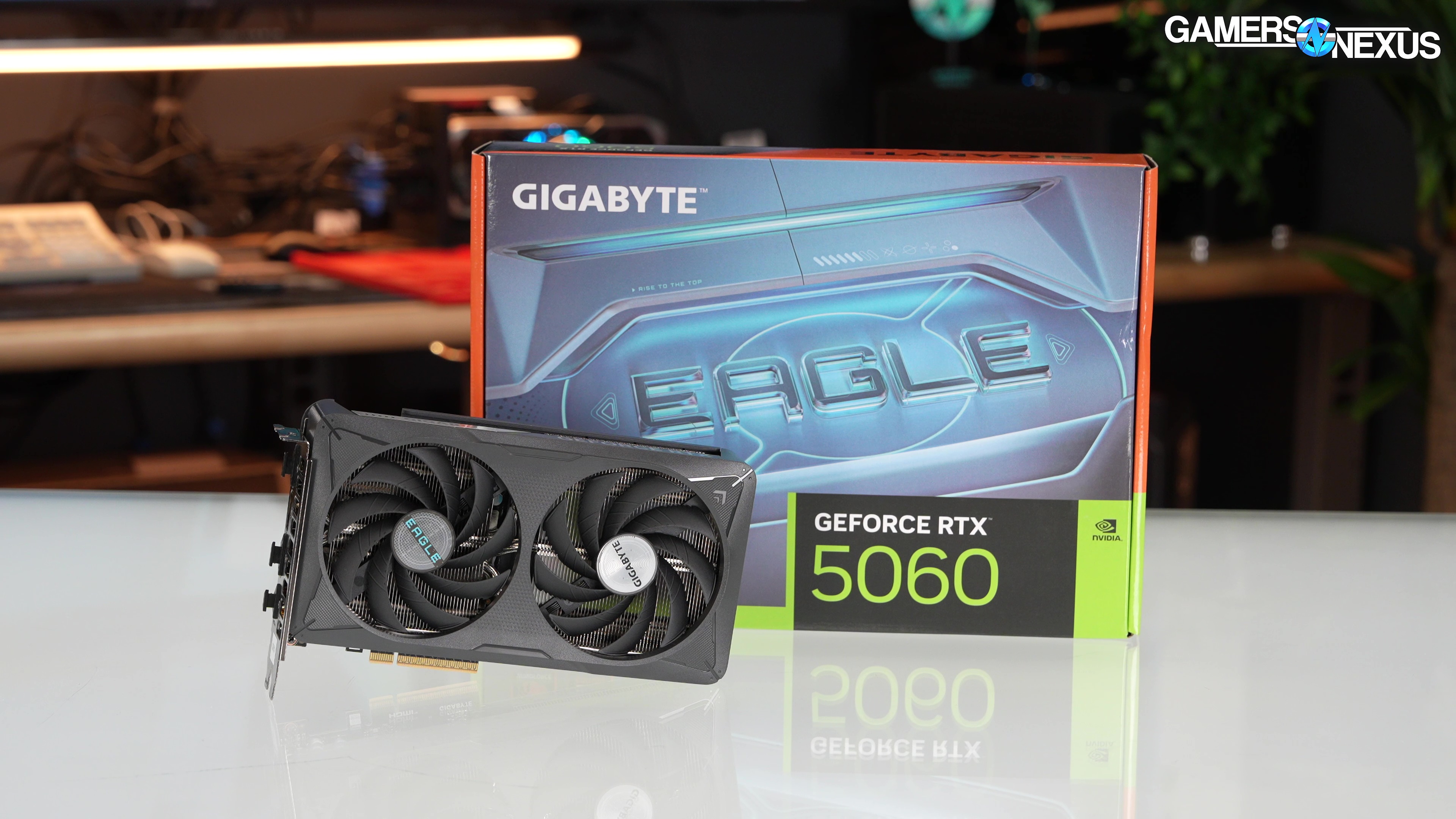
We test the RTX 5060 in several gaming benchmarks across 3 resolutions, which include rasterized and ray-traced tests
The Highlights
- NVIDIA did not seed out RTX 5060 GPUs for review
- The 5060 only has 8GB of VRAM, which will impose limitations in some scenarios
- Prospective buyers should also look at AMD’s RX 9060 XT
- Original MSRP: $300
- Release Date: May 19, 2025
Table of Contents
- AutoTOC

Intro
NVIDIA didn’t sample the RTX 5060, so we bought one while we were in Taiwan. Fortunately for our ability to get one, even a week after launch, they were in abundant supply and the stores told us that very few people were buying them.
Editor's note: This was originally published on June 3, 2025 as a video. This content has been adapted to written format for this article and is unchanged from the original publication.
Credits
Test Lead, Host, Writing
Steve Burke
Testing
Patrick Lathan
Camera
Mike Gaglione
Vitalii Makhnovets
Camera, Video Editing
Tim Phetdara
Writing, Web Editing
Jimmy Thang
Today, we’re reviewing the RTX 5060. We bought one in Taiwan and one from Newegg. The Newegg price was $330 and the Taiwan one was $360, so we’re ignoring MSRP and using the price we actually paid for purposes of this review. This is a post-launch review, which means we can use real price data rather than what largely turn out to be fake MSRPs for reviews. We’ll likely be buying all test samples of NVIDIA GPUs for some time, if not permanently, but that should make Jensen happy.
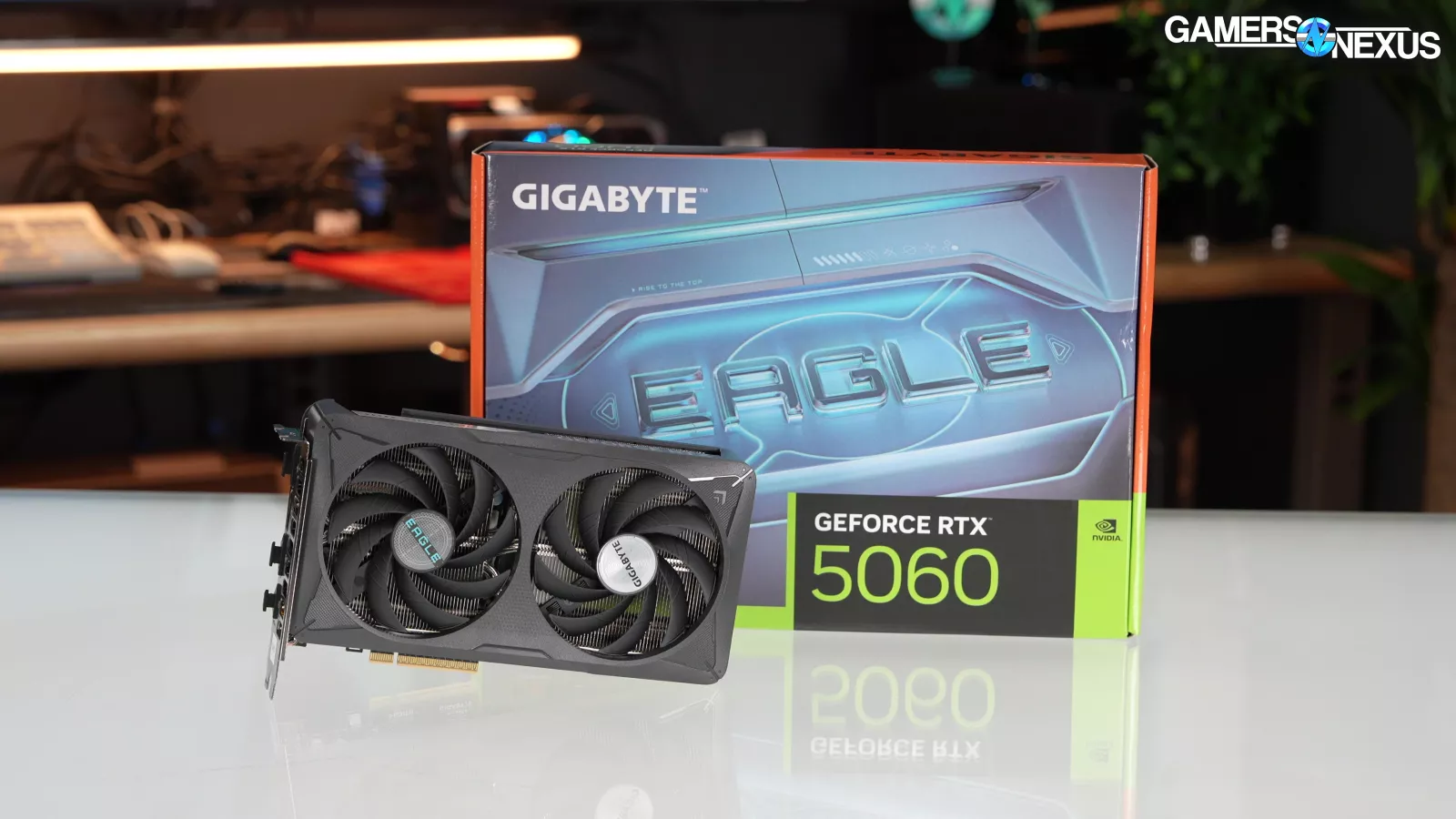
As quickly as possible: The 5060 is about the same as a 3070 (watch our review). The RTX 5060 Ti 16GB we tested is typically between 15% and 25% better than the 5060 across 1080p, 1440p, and 4K; the 5060 is typically slightly worse or slightly better than the 4060 Ti (watch our review); the 5060 is between 6% and 27% better than the 4060 (watch our review), commonly about 20%; the 5060 is also about 34% to 49% better than the RTX 3060 (watch our review) from 2021. But the VRAM is the big problem: 8GB becomes limiting at times, and will increasingly become a limiter.
There are a couple games where Intel’s B580 (read our review) performs at about the level of the new RTX 5060, but Intel still broadly has ground to gain. AMD’s RX 9060 XT will launch soon, so we’ll have a review of that shortly (Update: We have a review of that here).
In this review, we have data going back to the GTX 1060 6GB (watch our revisit) from 2016, which means the 5060 has added only 33% more memory in about a decade.
Let’s get into this quick review.
RTX 5060 Overview & Specs
The RTX 5060 remains readily available online.
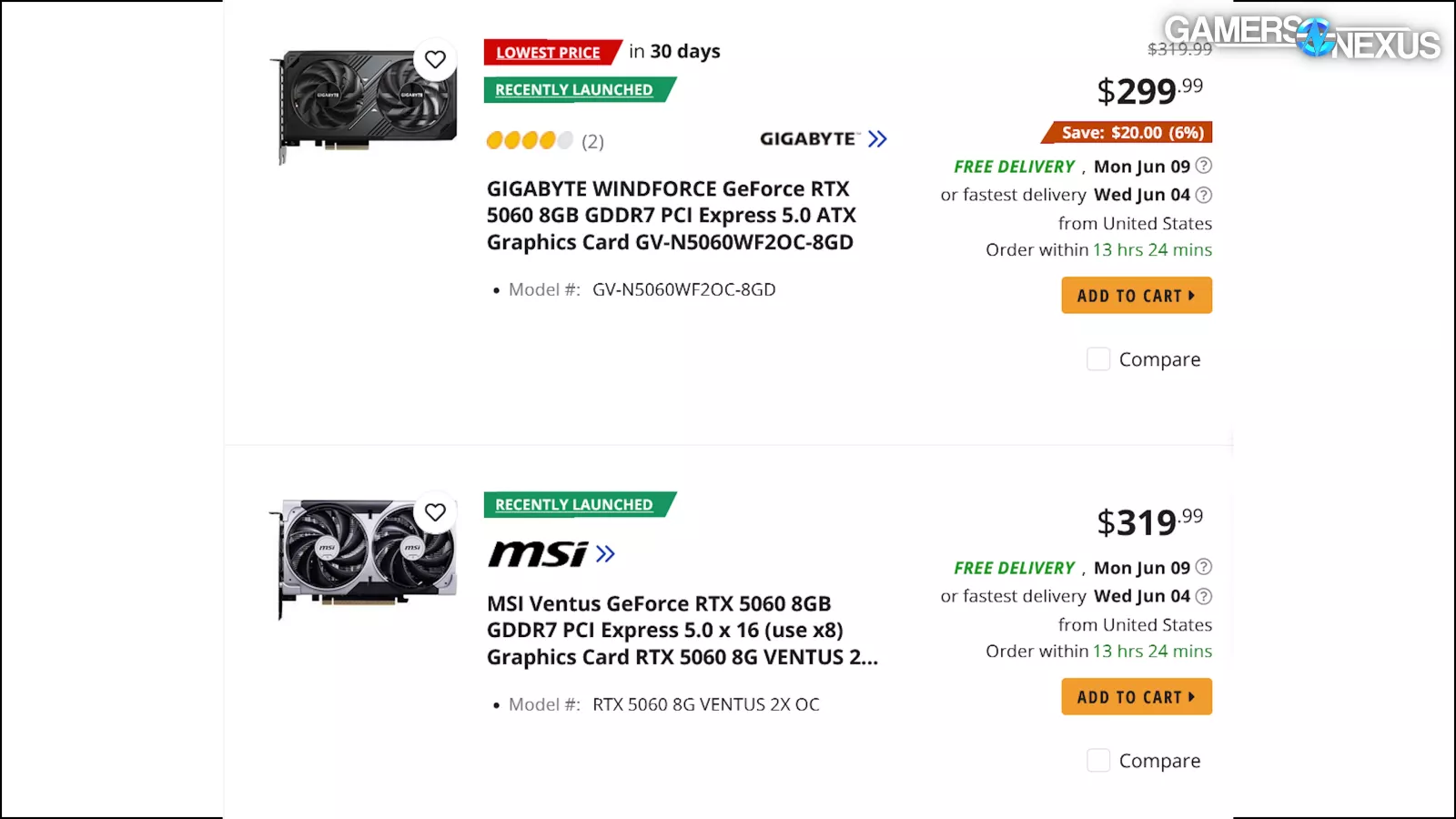
It ranges from $300 to $360 commonly, but as of writing this, we’re seeing options at $300 and $320 again. These were out of stock when we bought ours.
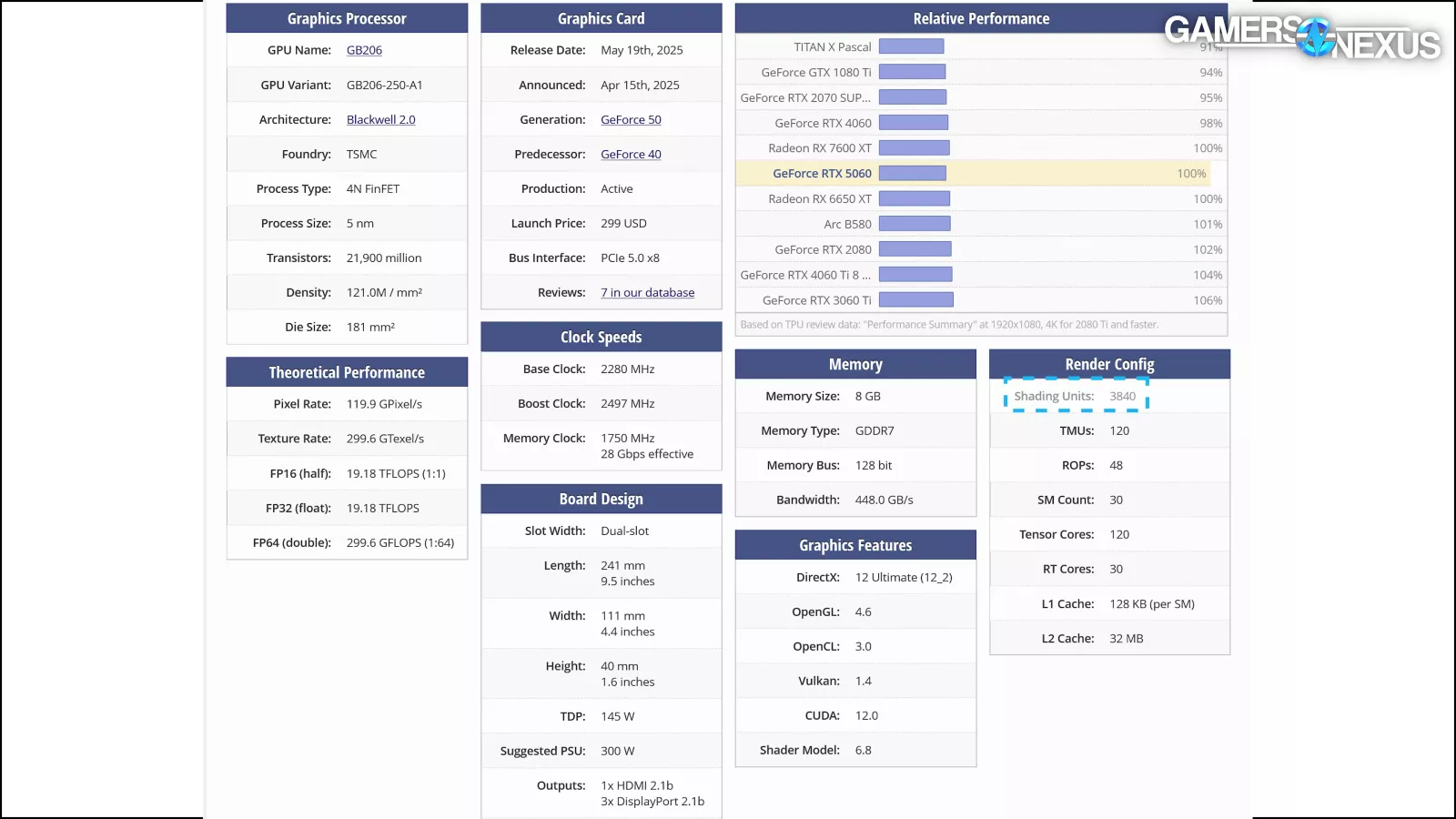
The RTX 5060 has 8GB of GDDR7 memory on an anemic 128-bit bus, 3840 CUDA cores, theoretically 48 ROPs, but who knows if they’re actually there, and uses GB206 for the core. It’s also on a PCIe 5.0 x8 interface, so it’s populating half of the available lanes.
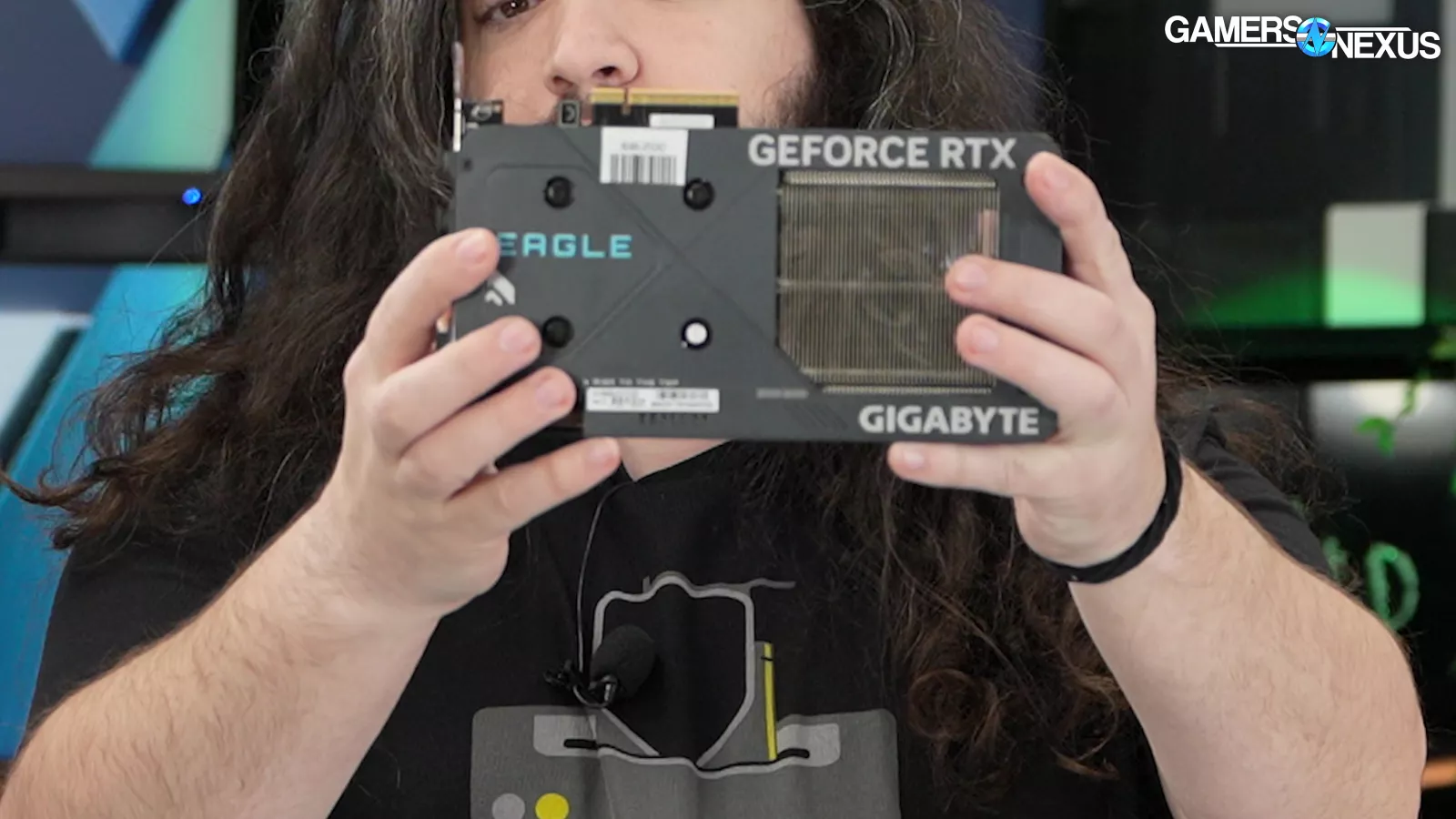
We purchased the Gigabyte Eagle OC model, which is really not that OC, but what makes it unique is that it uses a half-length slot.
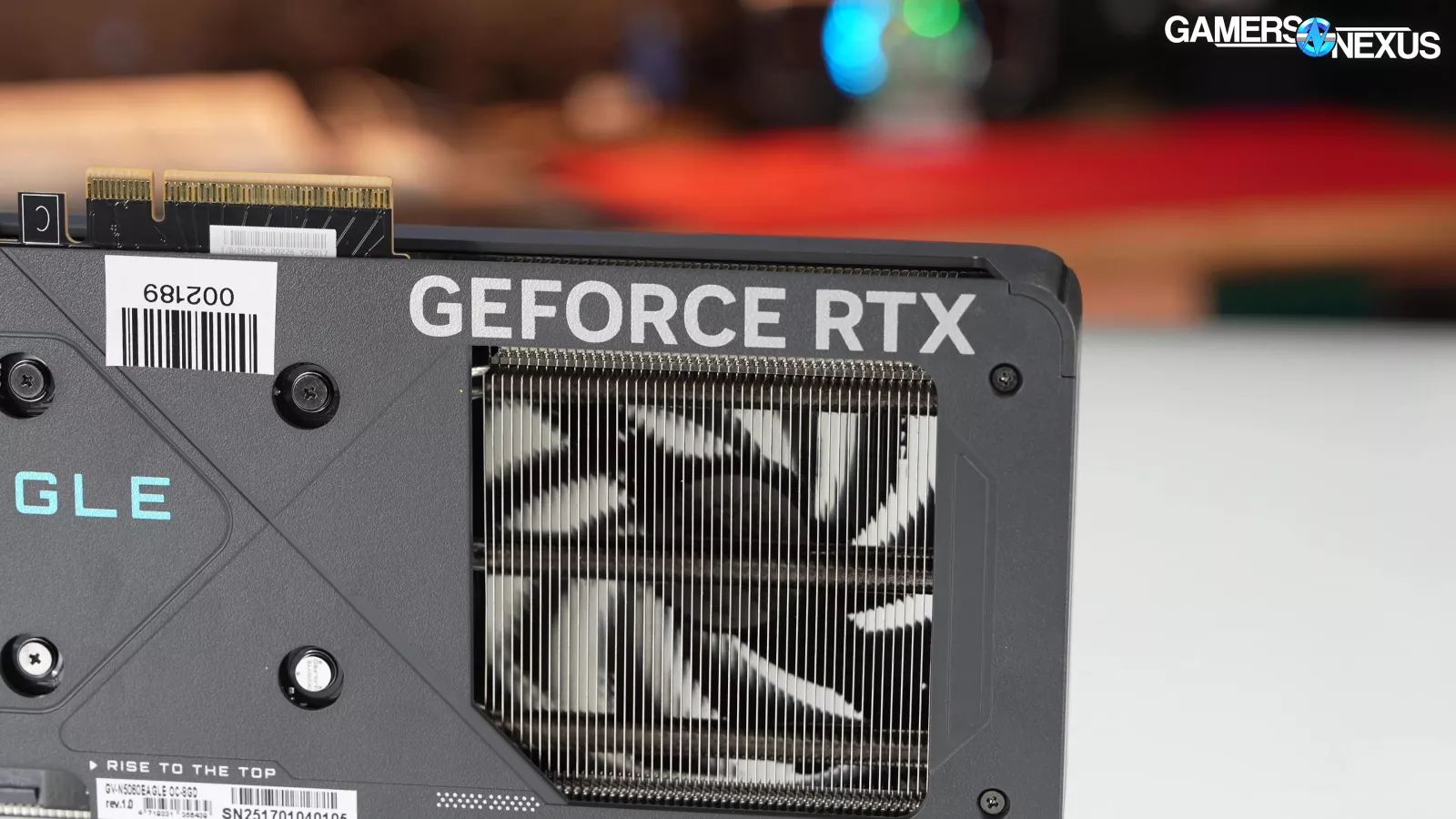
This is about as cut down a model as NVIDIA could have possibly made while still calling it RTX.
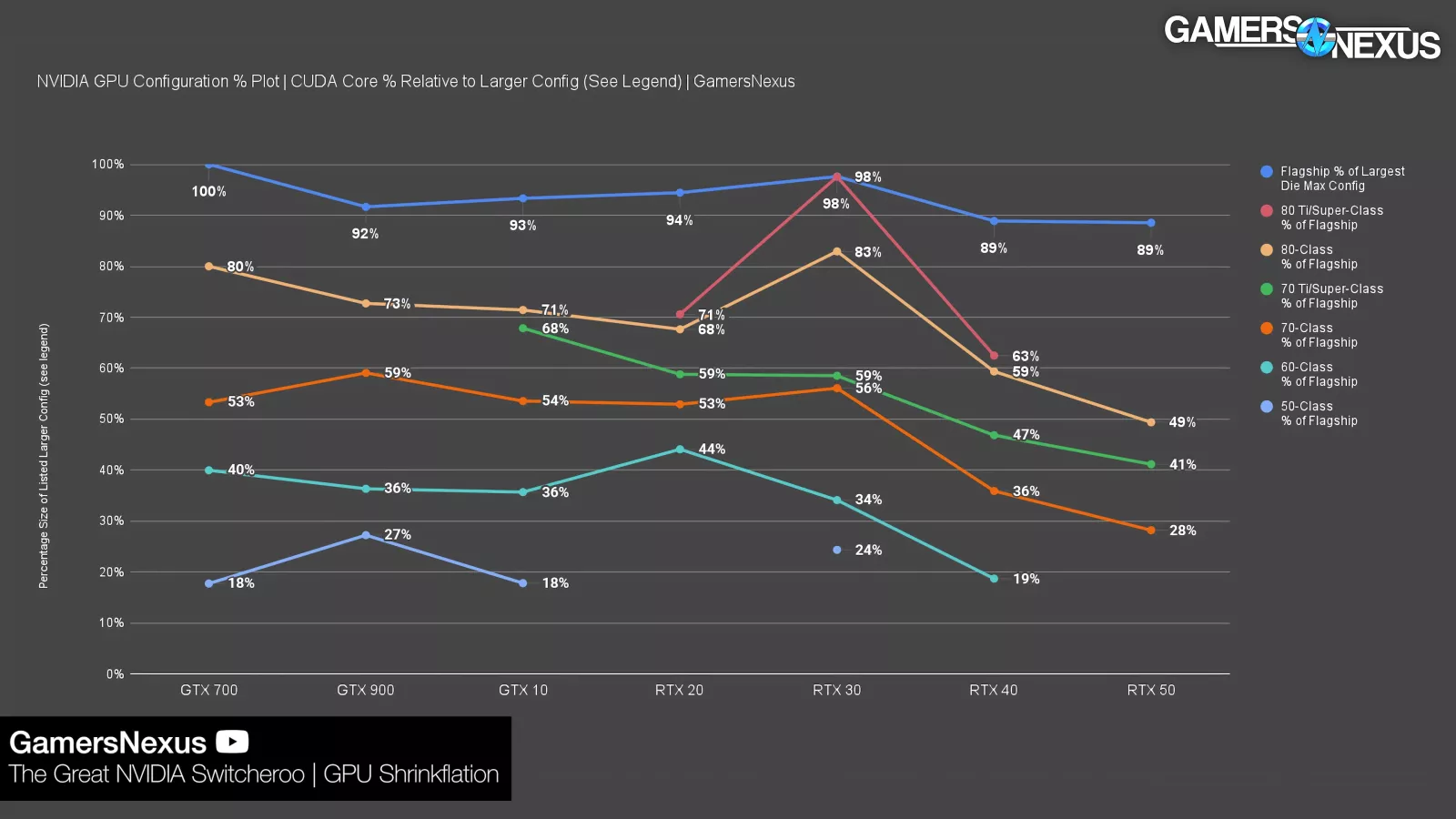
In our story about NVIDIA’s shrinkflation, we made this chart showing how NVIDIA’s modern RTX 4060 is similar to the GTX 750 in CUDA core percent relative to the larger configuration. In fact, its RTX 5070 was similar to an RTX 3050 (watch our review) by this metric. If we were to add the 5060 to this chart, it’d be at 15.6% of the full GB202 configuration and 17.6% of the 5090 (read our review) configuration.
This is hardly deserving of GeForce branding.
GPU Test Bench
| Part | Component | Provided By |
| CPU | Intel Core i7-12700KF Overclocked (4.9GHz P-Cores, 3.9GHz E-Cores) | Bought by GN |
| Motherboard | MSI Z690 Unify | MSI |
| RAM | DDR5-6000 G.Skill Trident Z (manually tightened timings) | G.Skill |
| Cooler | Arctic Liquid Freezer II 360 @ 100% Fan Speed | Bought by GN |
| PSU | EVGA 1600W T2 Supernova Corsair AX1600i | EVGA Corsair |
| OS | Windows 11 | Bought by GN |
RTX 5060 Rasterized Game Benchmarks
Starfield Benchmarks
Starfield - 1080p
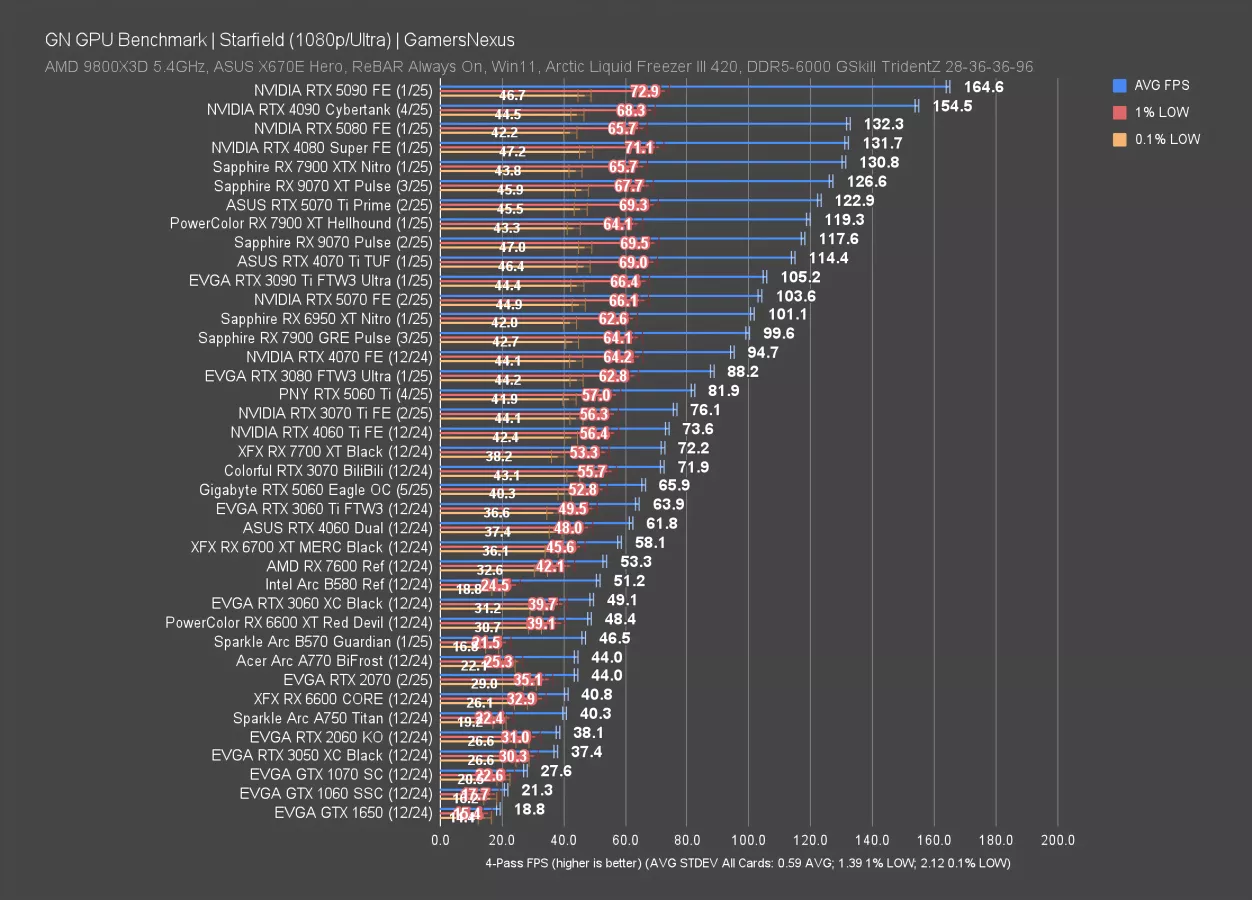
Starfield is up first.
At 1080p, the RTX 5060 ran at 66 FPS AVG and improved upon the 3060 Ti (watch our review) by an impressive, world-rending 3.1%. This is the improvement we came here for. This is why we buy GPUs. In just 5 short years and one dead AIB partner later, the EVGA 3060 Ti FTW3 has finally been unseated by a new 60-class card. Wow, that’s exciting.
Even more excitingly, the 5060 improves upon the 4060 by 4.1 FPS AVG. That’s such a big improvement that it’s almost noticeable. This 6.6% uplift isn’t something that you can get with just any technology: You have to actively try to produce this little of an improvement. If only we ran all of this through an arbitrary frame multiplier, it’d look more impressive.
Against the 6700 XT (watch our review), uplift is only 13%. Intel is still bested by NVIDIA: The B580 ran at 51 FPS AVG, yielding a 29% advantage to the 5060; however, the Arc GPUs have had issues with frametime pacing in this game that significantly hurt their viability beyond what the average FPS shows. You can see that in the 1% and .1% lows. Below that, the 3060 ran at 49 FPS AVG for a 34% uplift to the 5060, with the 2060 (watch our review) yielding a 73% improvement.
Starfield - 1440p
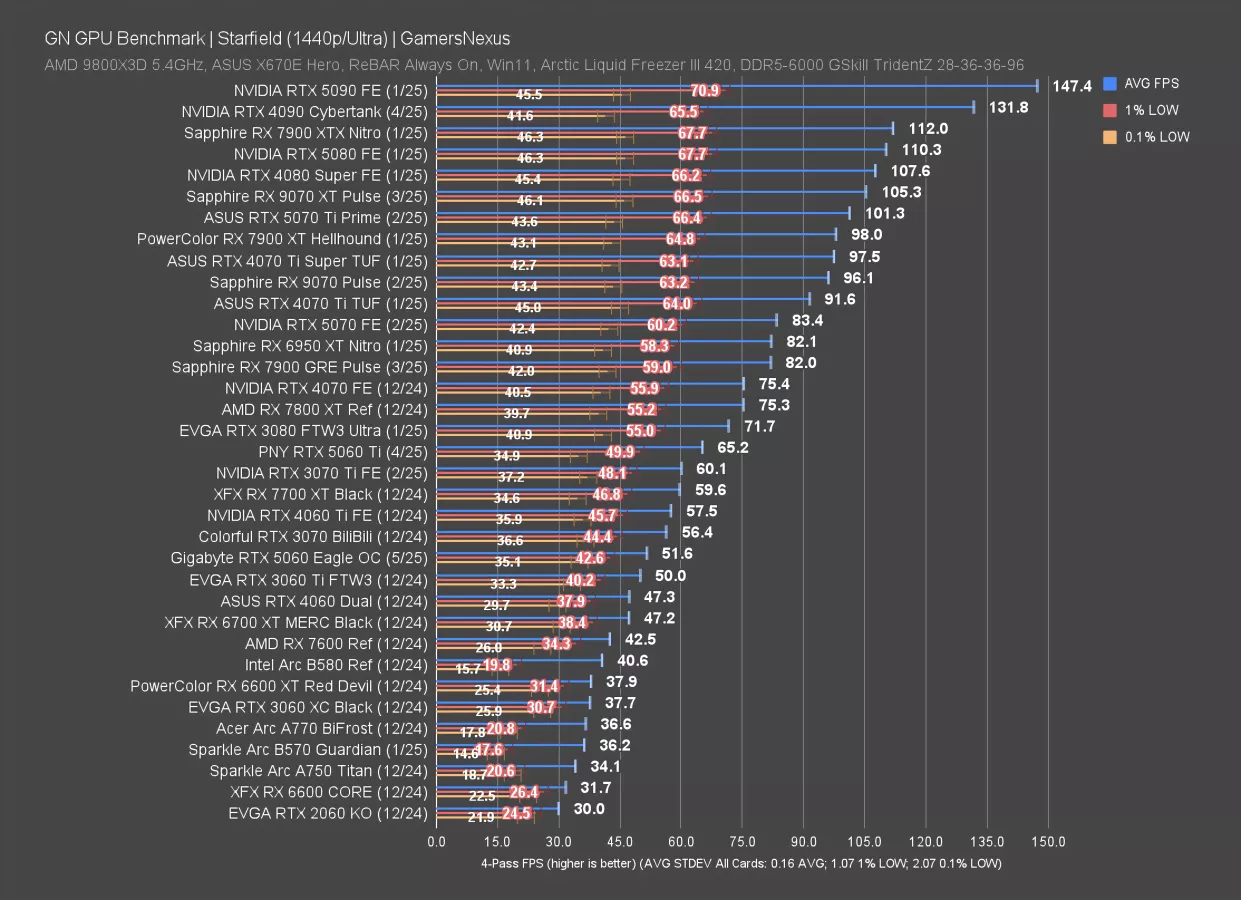
At 1440p, the 5060 ran at 52 FPS AVG and slightly trailed the RTX 3070. The lead over prior generations lines up like this: The 4060’s 47 FPS AVG is indistinguishable at a human level, though technically the 5060 is 9% better in average framerate. The same is true against the 6700 XT. Intel’s B580 is down at 41 FPS AVG and gives the 5060 an advantage of 27% (but again, with frametime pacing issues). The 3060’s 38 FPS AVG establishes a 37% improvement to the 5060 when spanning multiple generations, with the B570 (read our review) and A770 (read our revisit) both in a similar spot for the AVG FPS. Upgrading from an RTX 2060 in this exact test would produce a 72% improvement in average framerate.
But, unfortunately, for the 5060, the 4060 Ti and 3070 are both superior, and the 3060 Ti is functionally identical in performance to the new 5060. That’s just sad. The RTX 3060 Ti is almost too good by today’s standards, despite initial mixed reviews: It caused issues for the 4060 Ti at launch, and now it’s causing issues for the 5060.
Starfield - 4K
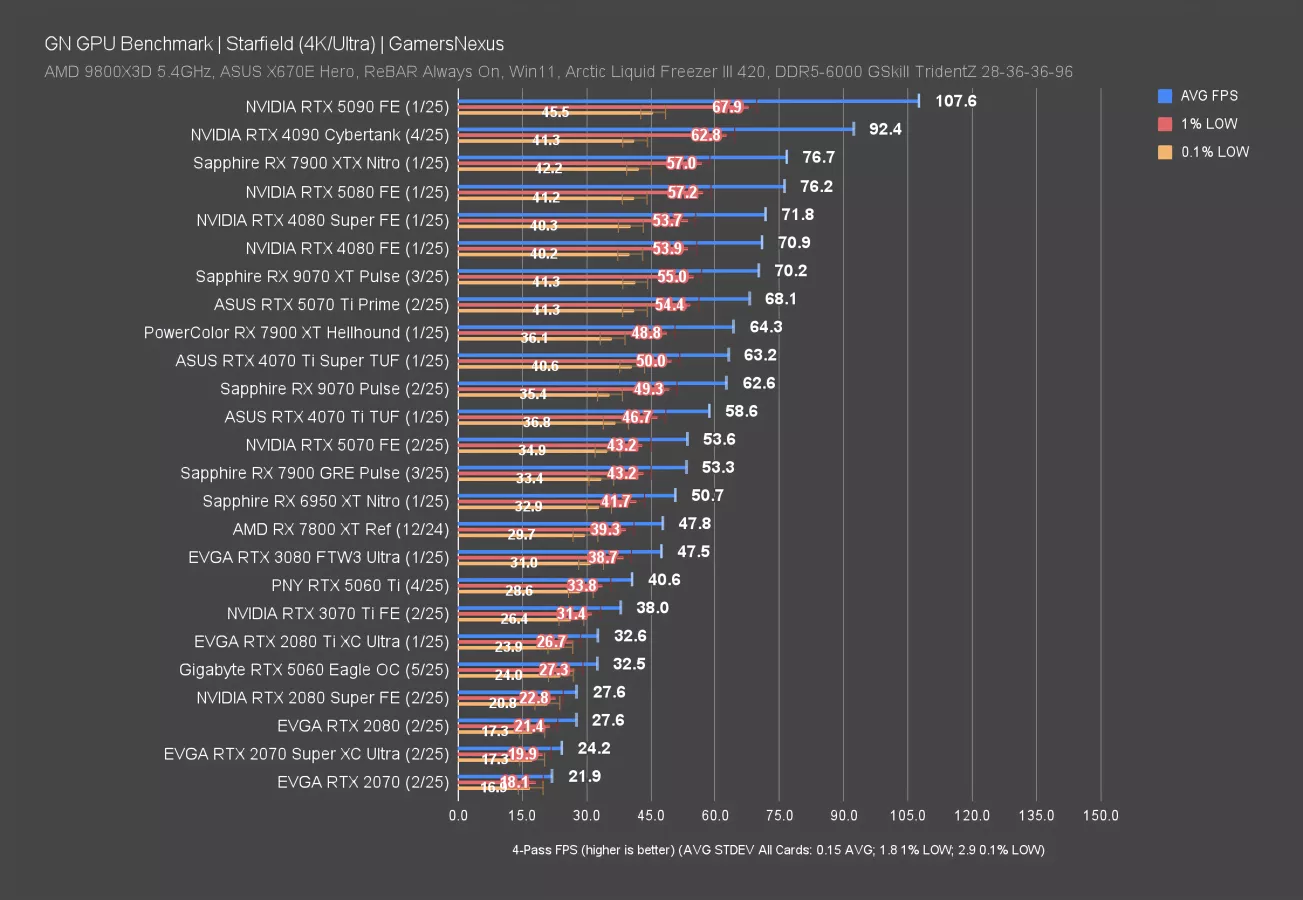
4K has fewer results because none of it really matters anyway.
The RTX 5060 ran at 33 FPS AVG in this test. What we care about is the relative comparison: The 5060 is beaten by the 3070 Ti (Watch our review) by 17%. The 5060 Ti is just past that marker at 41 FPS average, leading the 5060 by 25%. The 5070 (read our 5070 review) is next in the hierarchy, up at a 65% improvement. The RX 9070 (read our review) runs at about the level of the 4070 Ti (watch our review), but we’ll have to see where the 9060 XT falls soon.
Dragon's Dogma Benchmarks
Dragon’s Dogma 2 - 1440p
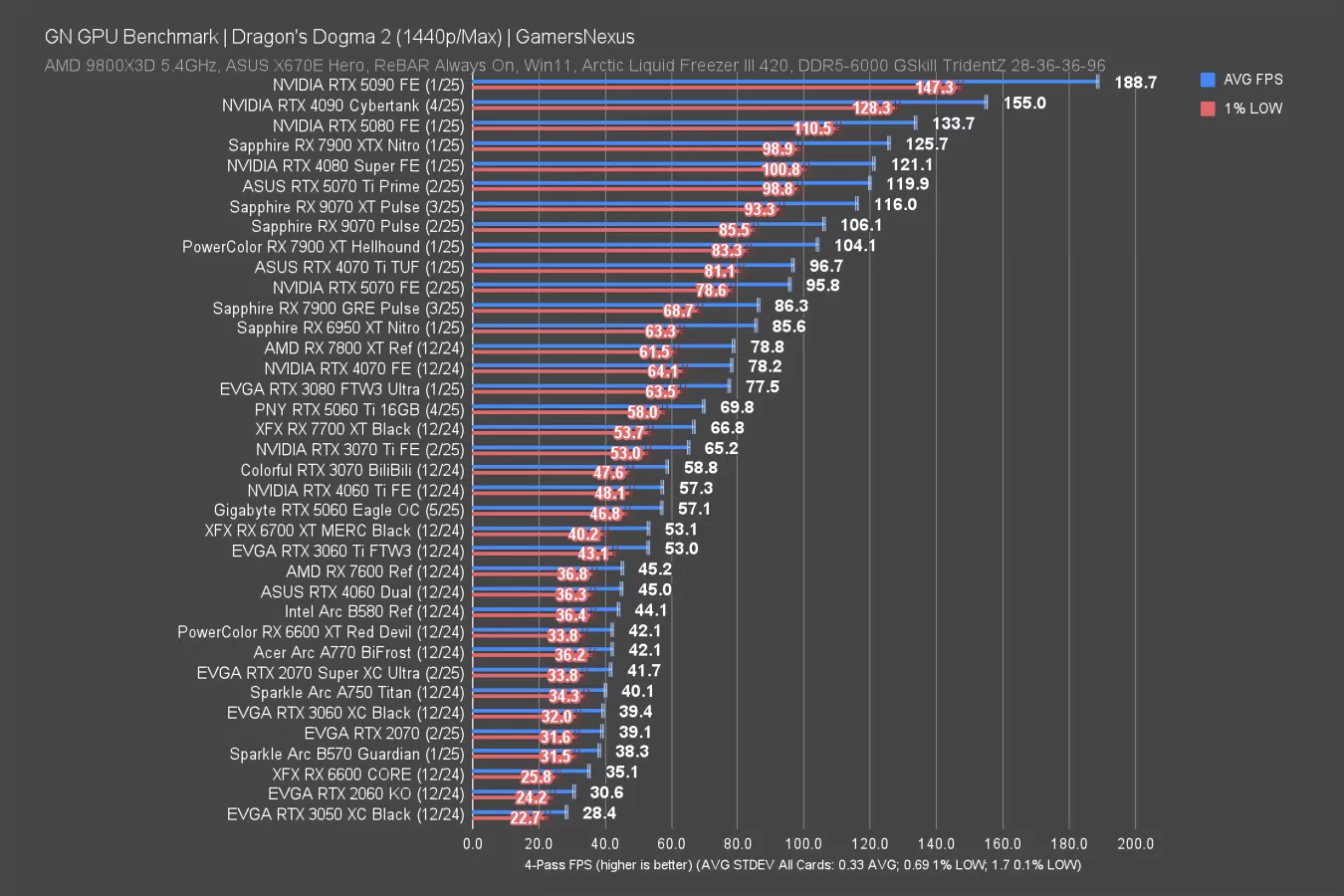
In Dragon’s Dogma 2 at 1440p, the RTX 5060 ran at 57 FPS AVG with lows at 45 to 47. Proportionally, these are well-spaced lows indicating good frametime pacing. The 5060’s average equates to the 4060 Ti 16GB’s from last generation, but with half the VRAM. The RTX 5060 Ti (16GB) outperforms the 5060 by 22% here. The 9060 XT would be interesting if we were allowed to show it already, but we might not have tested it yet, and if we had, we couldn’t show it.
We can show the 9070 though, and that’s at 106 FPS AVG with its own consistent frametime pacing. The lead over the 5060 is 86%. Pricing is also significantly higher, though.
The two-generation-old 6700 XT roughly equates the RTX 5060, as does the RTX 3070 also from a few generations back. We’re seeing sold eBay listings for around $270 to $320 for the RTX 3070, putting it in the same price class as a new RTX 5060.
The 3060 Ti ran at 53 FPS AVG, meaning it achieved 93% of the performance of the RTX 5060. The 3060 Ti was originally around $400 MSRP and today can be found in sold eBay listings for $150 to $260, with several selling around $230.
Intel’s Arc B580 ran at 44 FPS AVG in this test, allowing the RTX 5060 a lead of 30%. MSRP is $250 and the cards were commonly in the $400s for a while, but we’re seeing regular listings at $300 now. At price parity, in this game specifically, that makes the 5060 a better buy than the B580, but Intel is at least entering the conversation and it is competitive in some of the other games.
Against the last generation 4060, the 5060 leads by 27% at 57 FPS to 45 FPS AVG. Against the 3060 from 2021, the improvement is 45%. That’s not great for 4 years. Versus the 2060 from 2019, uplift is 87%.
AMD’s 9060 XT is what we need to really study in a few days.
Dragon’s Dogma 2 - 1080p
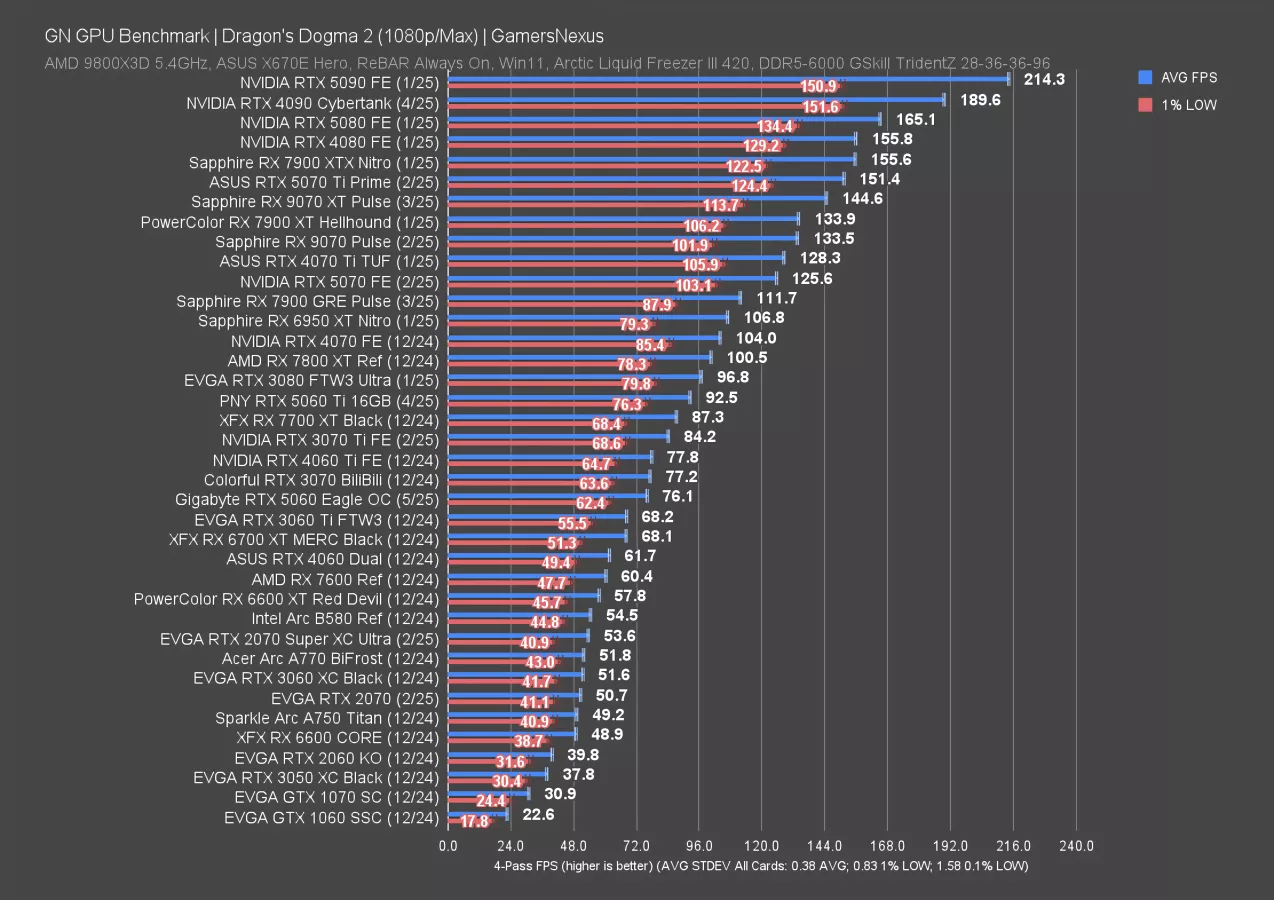
At 1080p, the RTX 5060 ran at 76 FPS AVG and held lows at 60 to 62 FPS. The 3070 again roughly equates the 5060, with the 3060 Ti only marginally behind at 68 FPS AVG. The 6700 XT ties the 3060 Ti, with the 5060 about 12% better than both. Generationally, the 5060 improves on the 4060 by 23%, the 3060 by 48%, the 2060 by 91%, and the 1060 by 237% -- although the GTX 1060 had a variant at 6GB, so somehow we’ve only improved on that by 33%.
Above the 5060, we have the 4060 Ti at a couple FPS ahead, which is just embarrassing for the 5060.
The 5060 Ti leads the 5060 by 22%, with the 5070 leading by 65% and 9070 by 75%. These latter two are significantly more expensive, of course, so that makes sense.
Final Fantasy XIV Benchmarks
FFXIV 4K
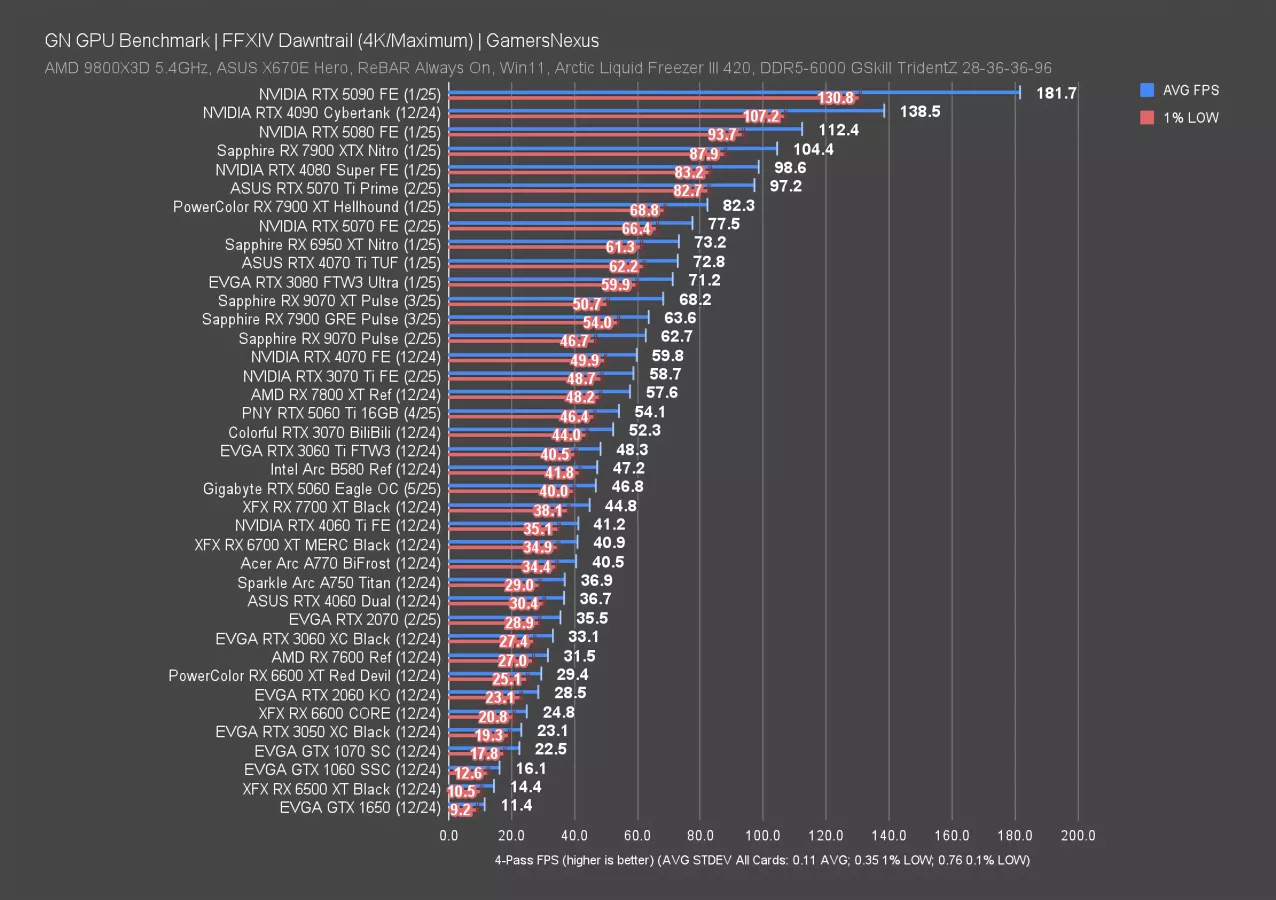
Final Fantasy 14: Dawntrail is up now, first at 4K. This particular set of tests is a weaker showing for the AMD RX 90 series, as we’ve shown in the 9070 XT review and 9070 review. NVIDIA is mostly competing against itself.
The RTX 5060 ran at 47 FPS AVG when at 4K, landing it below the Intel B580. That’s great news for Intel, considering this is only their second generation. Lows are the same between them, meaning frametime pacing is the same -- another victory for Intel, considering how new it is here.
The RTX 5060 Ti leads the 5060 by a paltry 16%, with the 4070 28% ahead and the 9070 34% ahead. Again, the 9070 series has not done well in Final Fantasy 14 in this testing and that shows here. The other direction, the 5060’s 47 FPS AVG leads the 4060 Ti by just 5 FPS, with the 6700 XT just behind that. For reference, sold 6700 XT 12GB listings have the card between $200 and $320. The A770 is just below that, giving the 5060 just a 16% lead. Generationally, the 5060 leads the 4060 by 28%, the 3060 by 41%, the 2060 by 64%, and the 1060 by 191%.
FFXIV 1440p
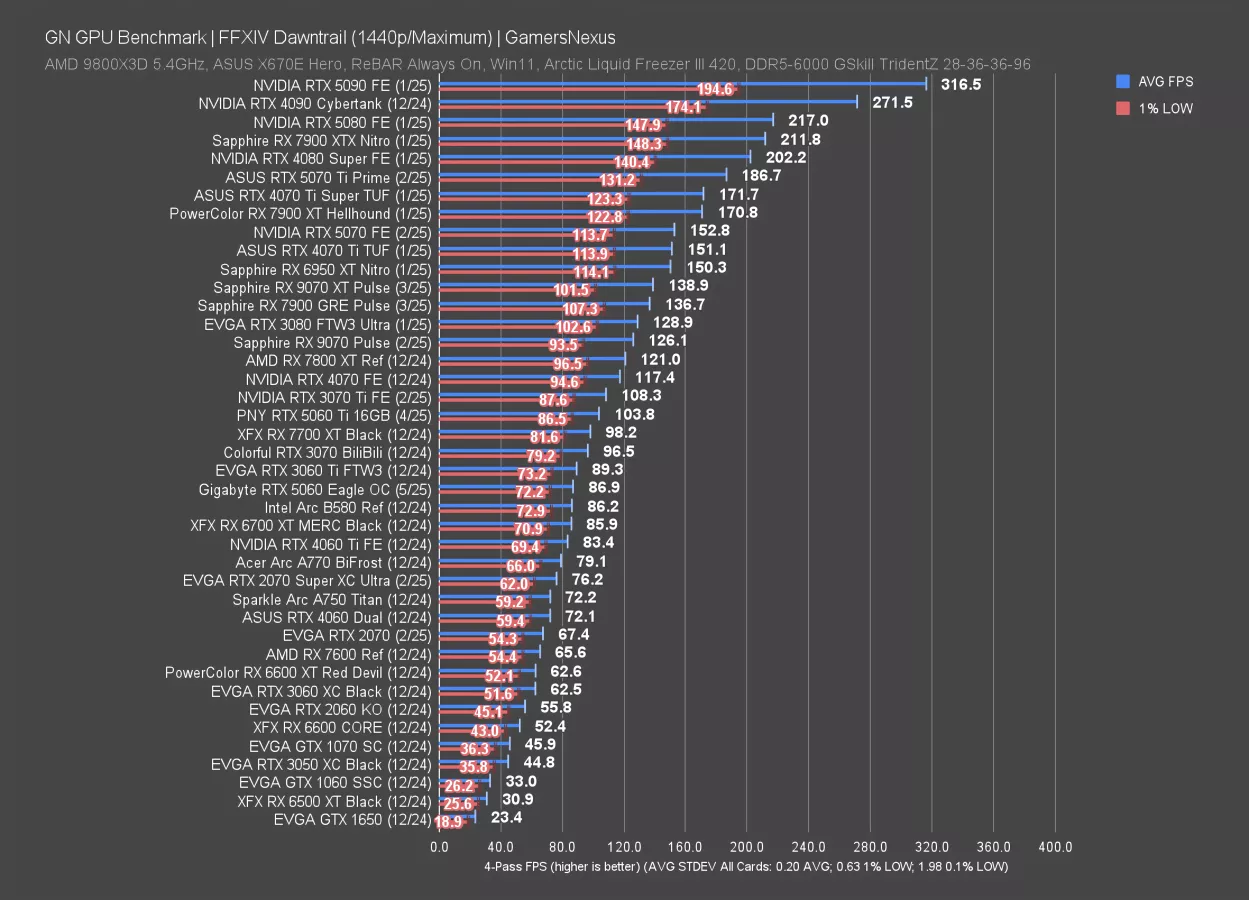
1440p has the 5060 again tied with Intel’s B580, again in an embarrassing showing for NVIDIA. If Intel keeps at it, the company may have a real chance at disruption -- the hard part for Intel will be maintaining competitive prices while often using larger dies to be competitive.
The 3060 Ti leads the 5060 in another embarrassment for NVIDIA, at 3% ahead of the 5060. The 3070 and 7700 XT are next in line, followed by the 5060 Ti 16GB at 19% ahead. The gap over the 5060 increases at 1440p versus 4K based on these numbers.
Generationally, the 5060 uplift over the 4060 Ti is just 4%, or 21% over the 4060, 39% over the 3060, 56% over the 2060, and 163% over the 1060. All of these numbers are down versus the improvement at 4K.
Resident Evil 4 Benchmarks
Resident Evil 4 - 4K
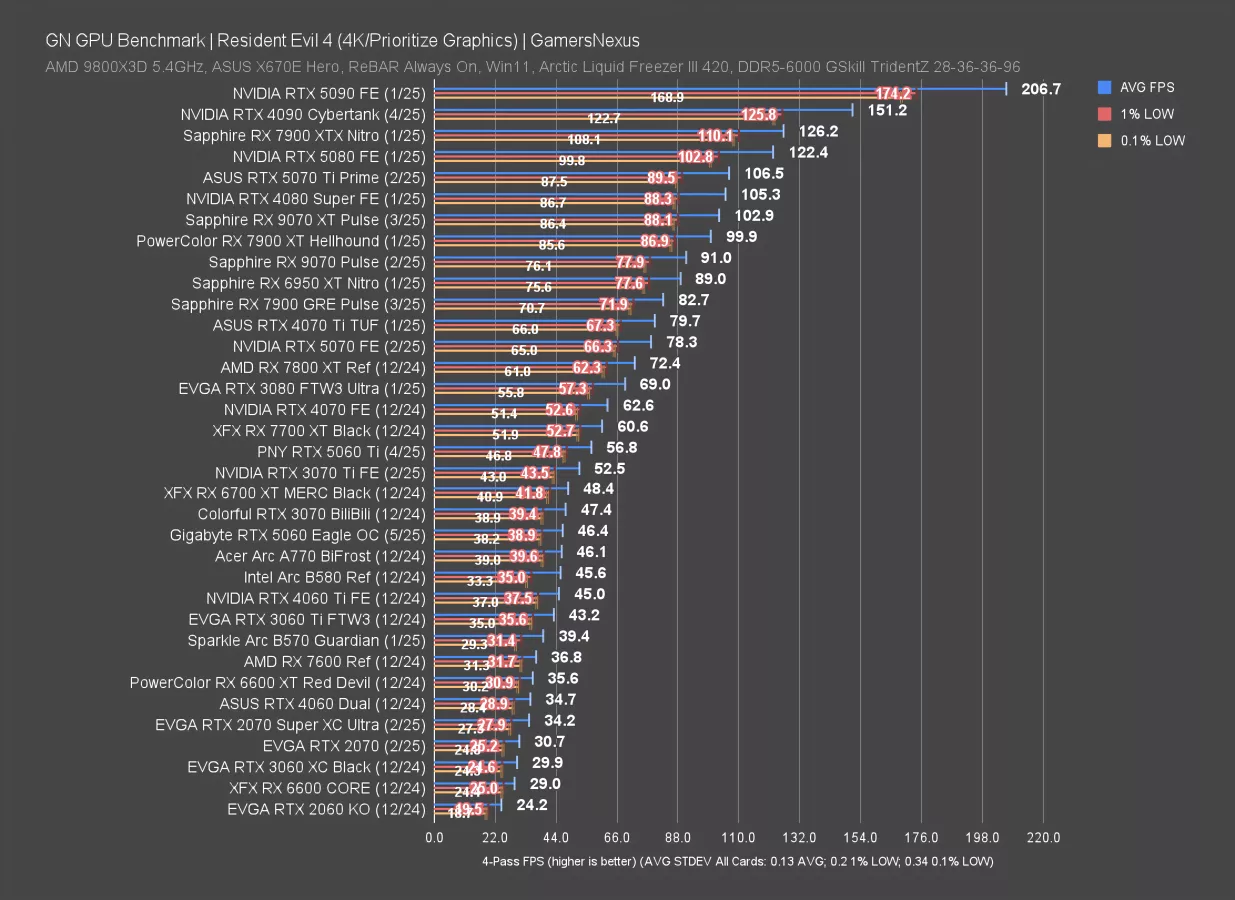
Resident Evil 4 at 4K has the RTX 5060 at 46 FPS AVG, again basically tying the RTX 3070 -- but there’s something worse this time: The A770 also ties the 5060, with the B580 just behind. The RTX 5060 Ti leads the 5060 by 22% here. We’ll have to see if the 9060 XT falls anywhere near this area. For now, the 9070 is 96% ahead at a much higher base price.
Against older parts, the 5060’s 46 FPS AVG has it basically tied with the 4060 Ti and only 7% ahead of the 3060 Ti. The B570 sits down here too, with the 4060 down at 35 FPS AVG to give the 5060 a lead of 34%. Improvement on the 3060 is 55%, with the uplift on the 2060 at 92%.
Resident Evil 4 - 1440p
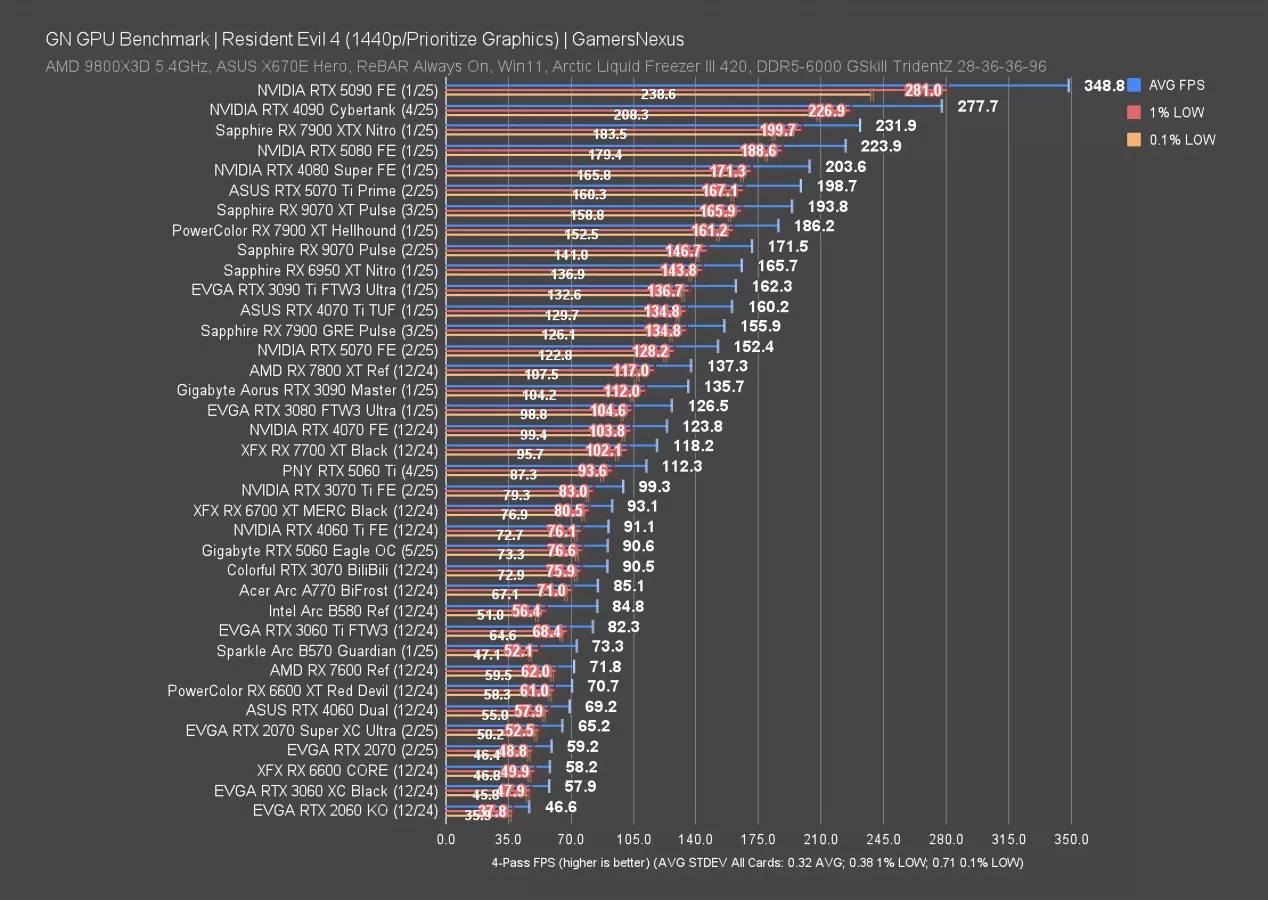
At 1440p, the RTX 5060 ran at 91 FPS AVG and kept frametime pacing consistent. Not in a remarkable way, but a predictable one: Most of the GPUs tested in this game fare well for frametime pacing, and the 5060 is among them. The 4060 Ti had a result functionally equal to the 5060, with the 6700 XT slightly ahead of both and in all 3 metrics. The 3070 Ti is next, with the 5060 Ti at 112 FPS and ahead of the 5060 by 24%.
Below the 5060, the A770 and B580 both encroach on its rank at about 85 FPS AVG. Unfortunately for Intel though, frametimes are inconsistent on these cards, as shown in the low variability for the B580 as compared to the A770 and 5060. Arc still has ground to gain here.
Versus lower down GPUs, the 5060 improves upon the 3060 Ti FTW3 by 10%, the B570 by 24%, 6600 XT by 28%, 4060 by 31%, and 2060 by 94%.
Black Myth: Wukong Benchmarks
Black Myth: Wukong - 4K
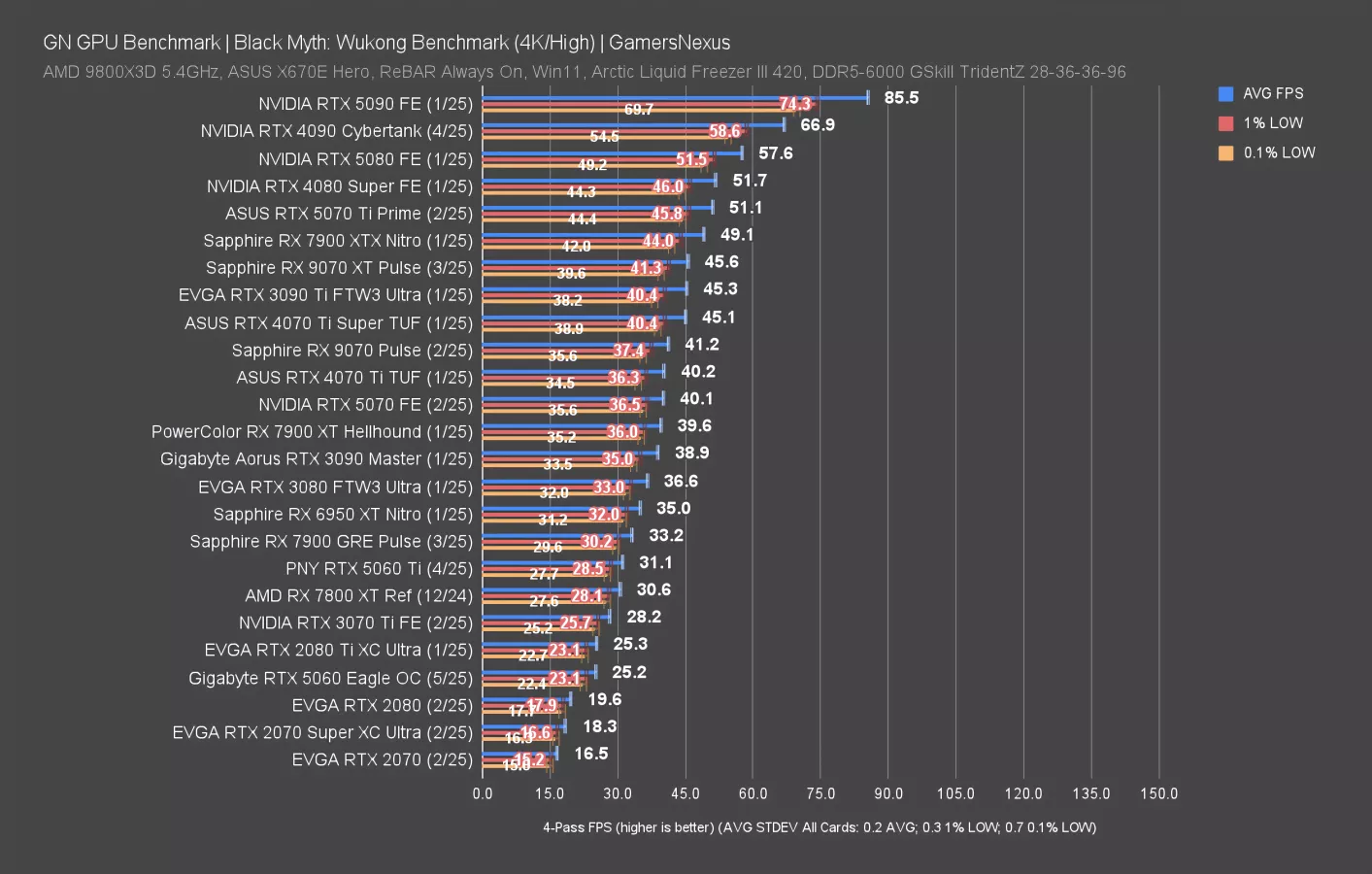
Black Myth: Wukong is next, which is a title that does particularly well with NVIDIA devices (and disproportionately so in ray tracing).
Predictably, 4K is unplayable on the RTX 5060. The 5060 ends up at 25 FPS AVG. From a relative standpoint, the 5060 Ti has a 23% higher average framerate, which is consistent with other tests. The 5070 is 59% better here and approaching playability, but isn’t there yet. The 9070 is around the same level as the 5070, including in 1% and 0.1% lows.
Let’s move on to something more realistic.
Black Myth: Wukong - 1440p
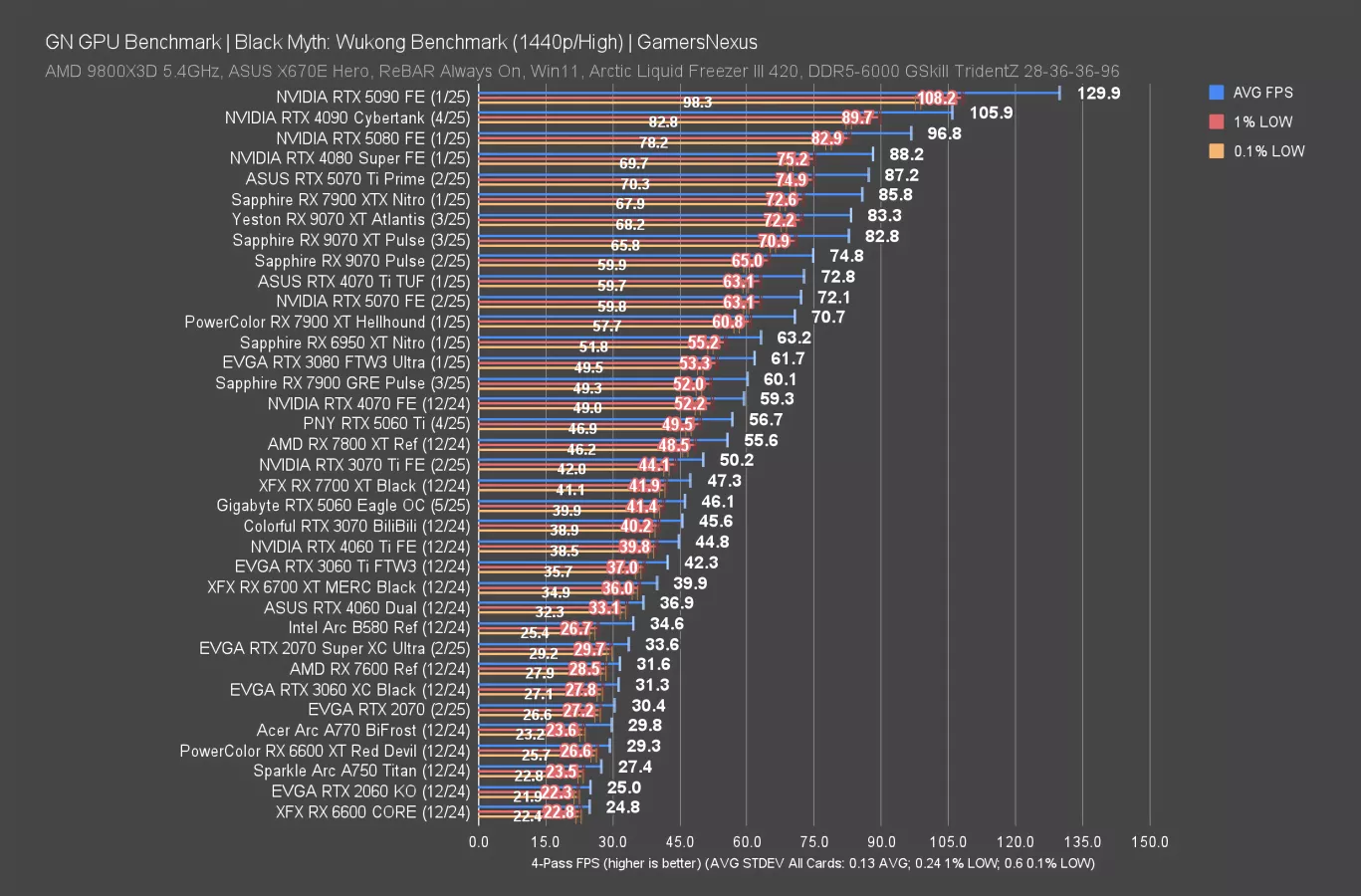
At 1440p, the RTX 5060 runs at 46 FPS AVG with frametime pacing consistent, not different from most other cards in this test (with the exception of Intel). The 5060 is about tied with the RTX 3070 and the RX 7700 XT. Realistically, the 4060 Ti 16GB is also at about the same performance as the 5060 here, but with way more VRAM. The 3060 Ti’s 42 FPS AVG means that the 5060 has improved upon it by just 9%. Generationally, the 5060 is 25% ahead of the RTX 4060, 47% ahead of the 3060, and 84% ahead of the RTX 2060.
Black Myth: Wukong - 1080p

At 1080p, the RTX 5060 held a playable 66 FPS AVG with lows representing consistent frametimes. The 7700 XT, 4060 Ti 16GB, and 3070 are all indistinguishable in experience for the player. The 3070 Ti isn’t much different.
The 5060 ends up better than the 3060 Ti by only 13.5%. It improves on the 4060 by 21% and Intel’s B580 by 44%.
Dying Light 2 Benchmarks
Dying Light 2 - 4K

Dying Light 2 rasterized is up next. At 4K, the RTX 5060 ran at just 32 FPS AVG and tied the RTX 2080 Ti from 2018. The RTX 5060 Ti leads the 5060 by 21%. We need to move down in resolution to see other cards.
Dying Light 2 - 1440p
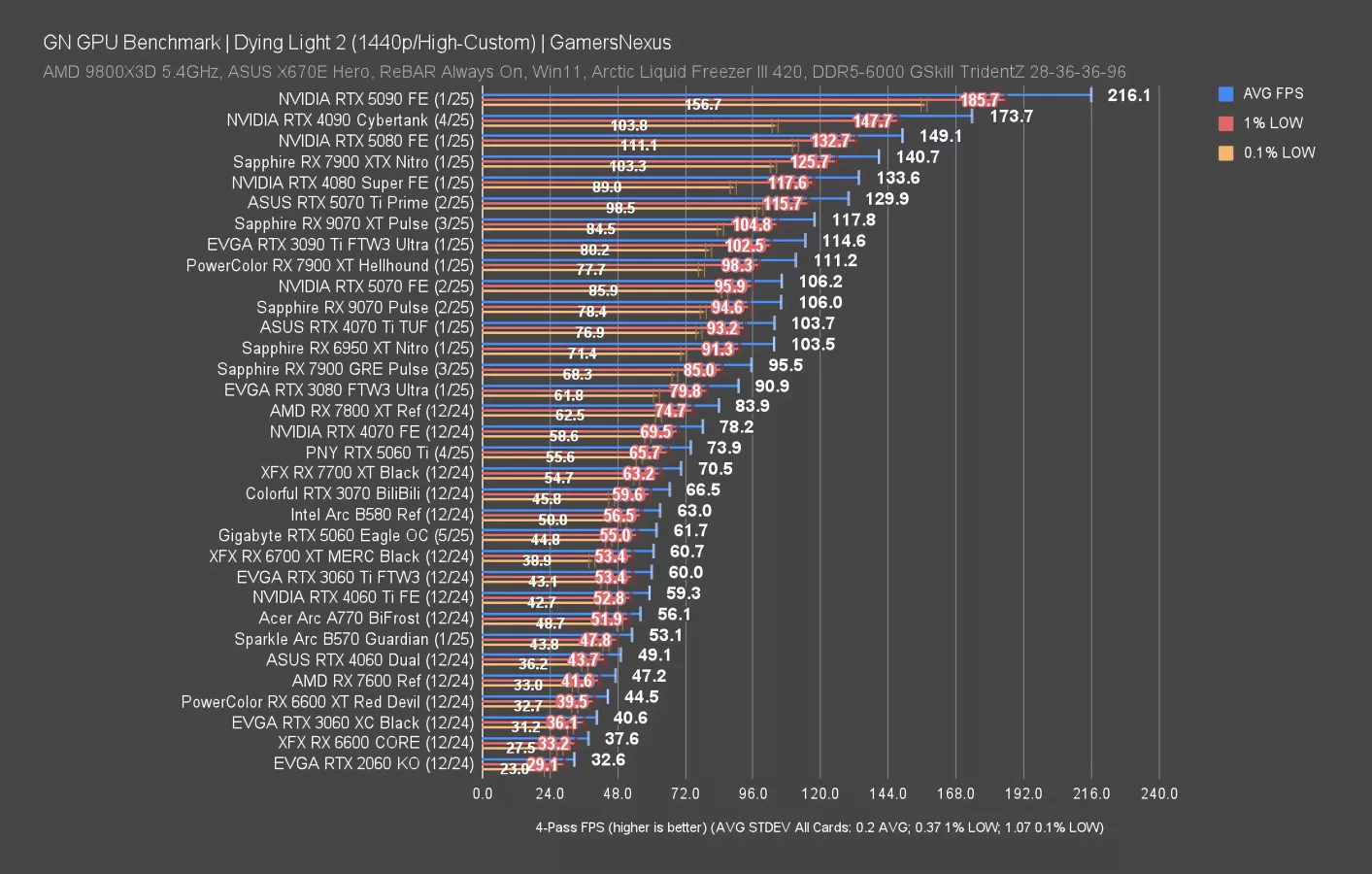
1440p adds a lot of devices to the charts. The RTX 5060 is now at 62 FPS AVG, performing about the same as the RX 6700 XT and, again disappointingly for NVIDIA, the RTX 3060 Ti. This was also one of the games where the 3060 Ti embarrasses the 4060 Ti, so at least we see that trend continuing for one last generation. Even Intel’s B580 outperforms the RTX 5060, this time in both the average framerate and the lows.
The 5060 Ti outperforms the 5060 by 20% here. Against the 4060 Ti, the 5060 is roughly equivalent (again), with the uplift over the 4060 at 26%, followed by the 3060 at 52% improved to the 5060.
Cyberpunk 2077: Phantom Liberty Benchmarks
Cyberpunk 2077: Phantom Liberty - 4K
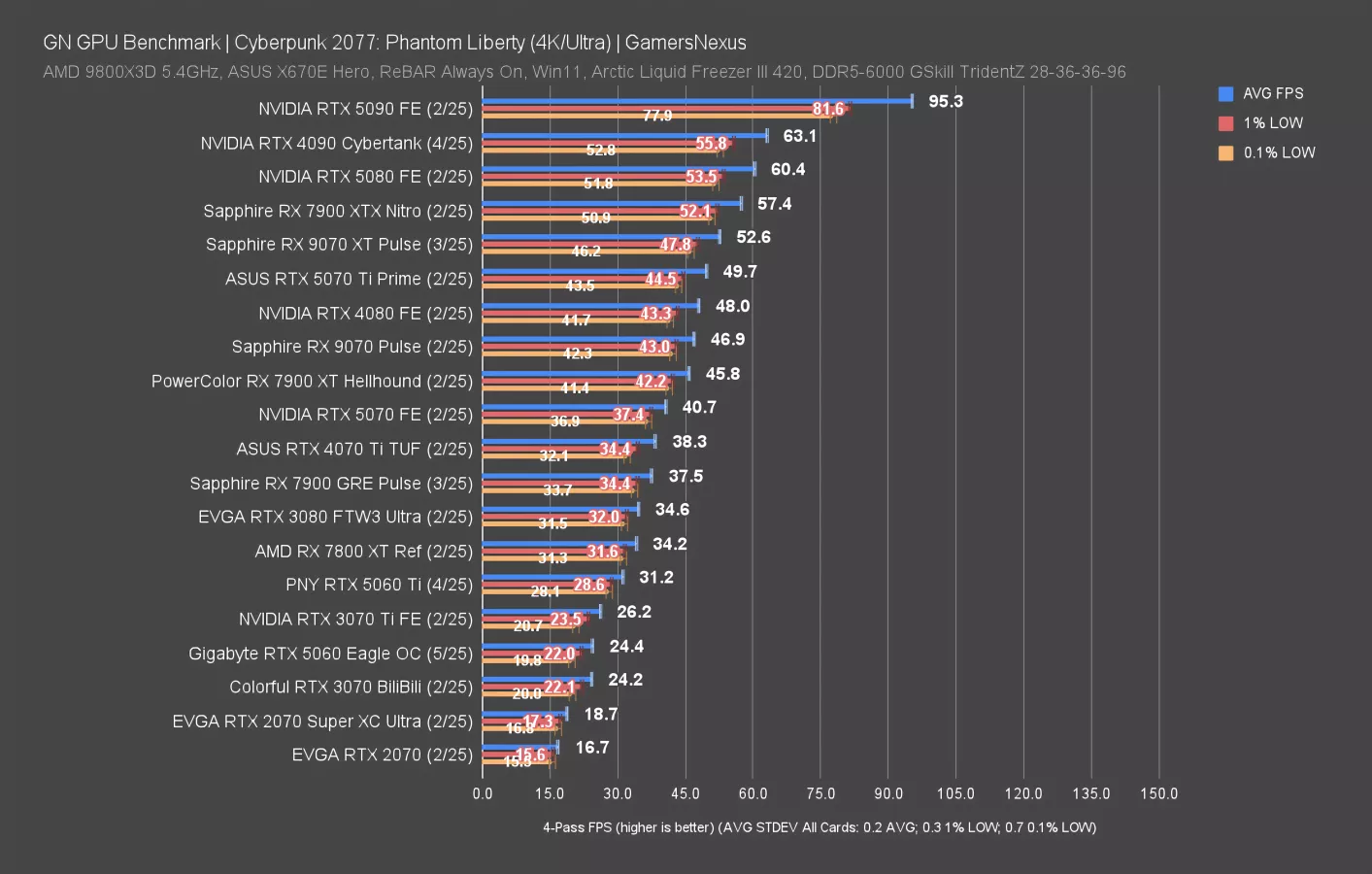
Cyberpunk 2077: Phantom Liberty is up now.
At 4K and rasterized, the 5060 ran at 24.4 FPS AVG. This is only useful for a relative comparison. That’s the same as the RTX 3070 and slightly behind the 3070 Ti. The 5060 Ti is 28% ahead in average framerate here, with the 7800 XT ahead of that.
Cyberpunk 2077: Phantom Liberty - 1440p
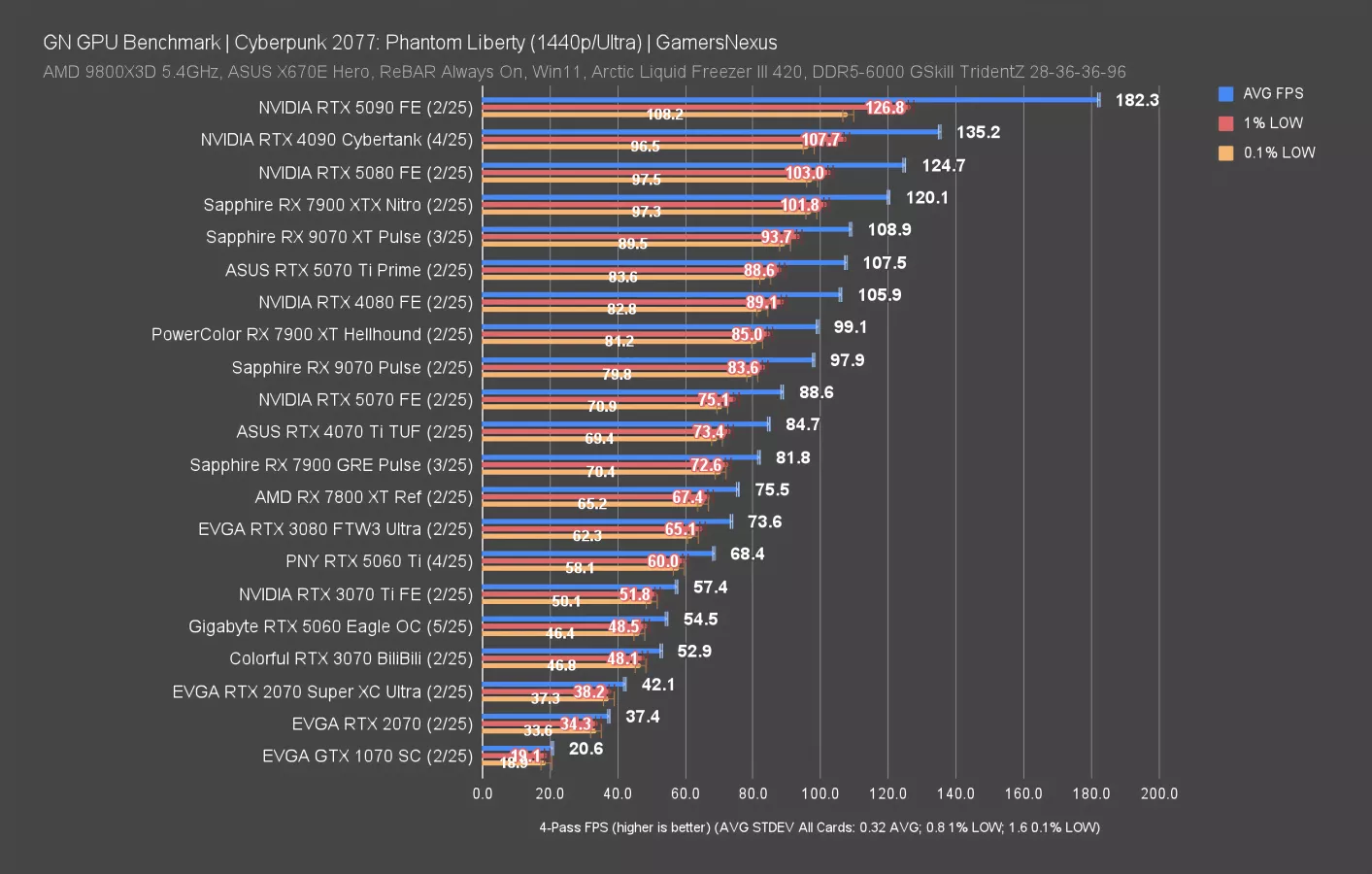
At 1440p, the 5060 hits 55 FPS AVG in this test. That has it right between the 3070 Ti and 3070 and experientially the same. The 5060 Ti is better in average framerate by 26%.
Cyberpunk 2077: Phantom Liberty - 1080p
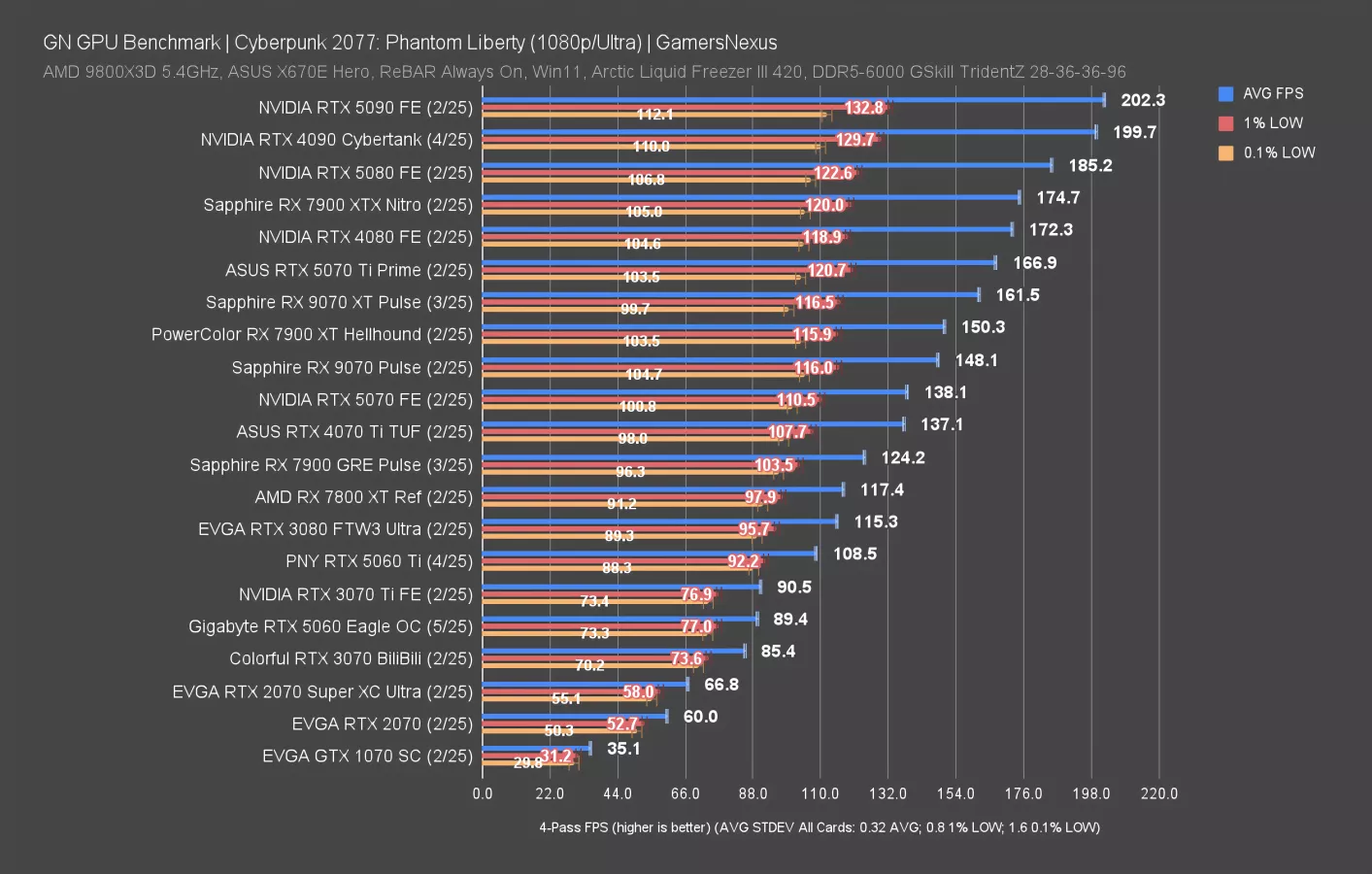
At 1080p, the RTX 5060 moves up to 89 FPS AVG and remains sandwiched by the 3070 and 3070 Ti. We haven’t re-run the 4060 through this test lately, but the 9060 XT will definitely be an interesting data point to see.
RTX 5060 Ray Tracing Benchmarks
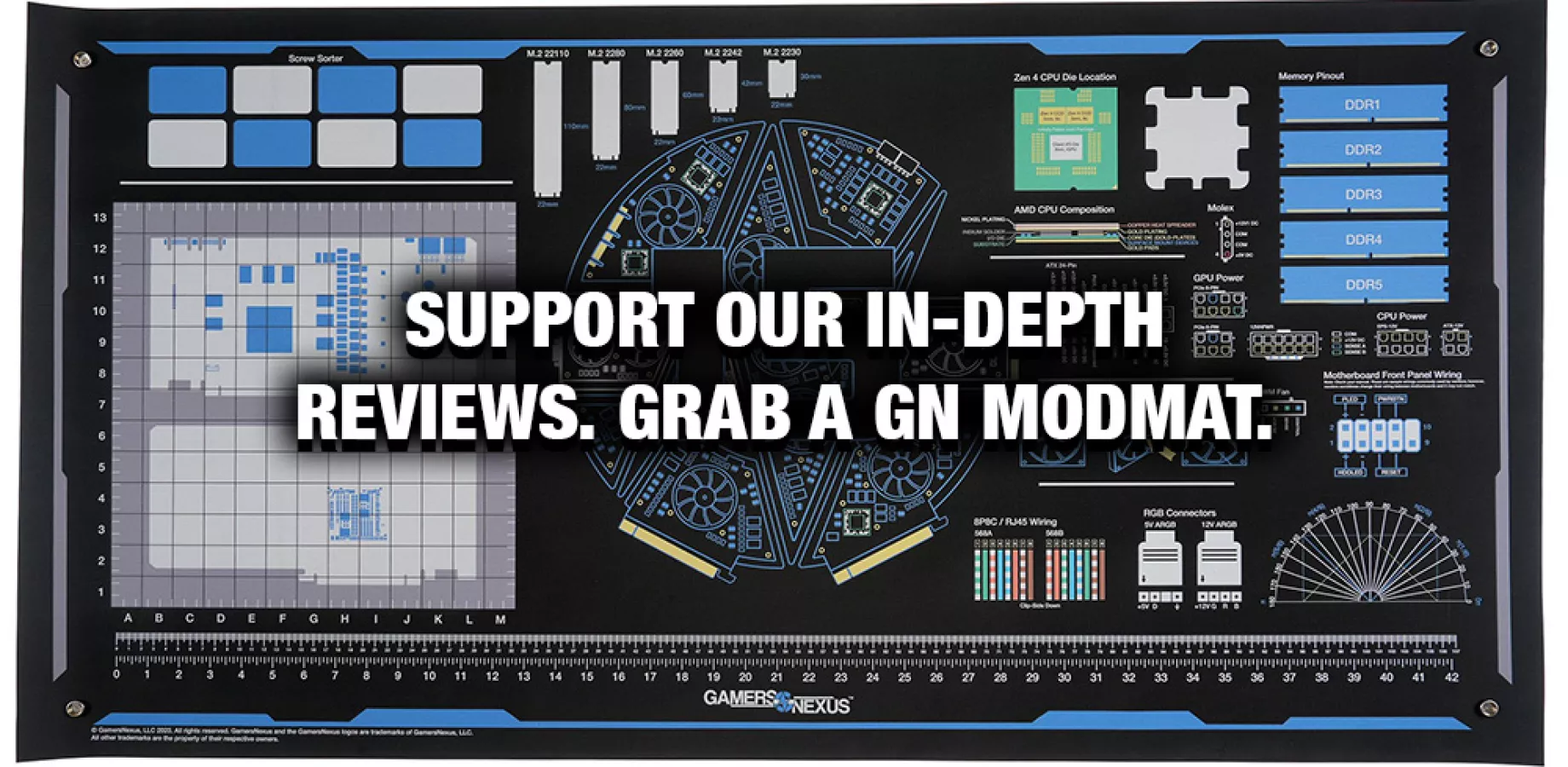
Moving on to ray tracing testing now.
Black Myth: Wukong Ray Tracing Benchmarks
Ray Tracing - Black Myth: Wukong 4K
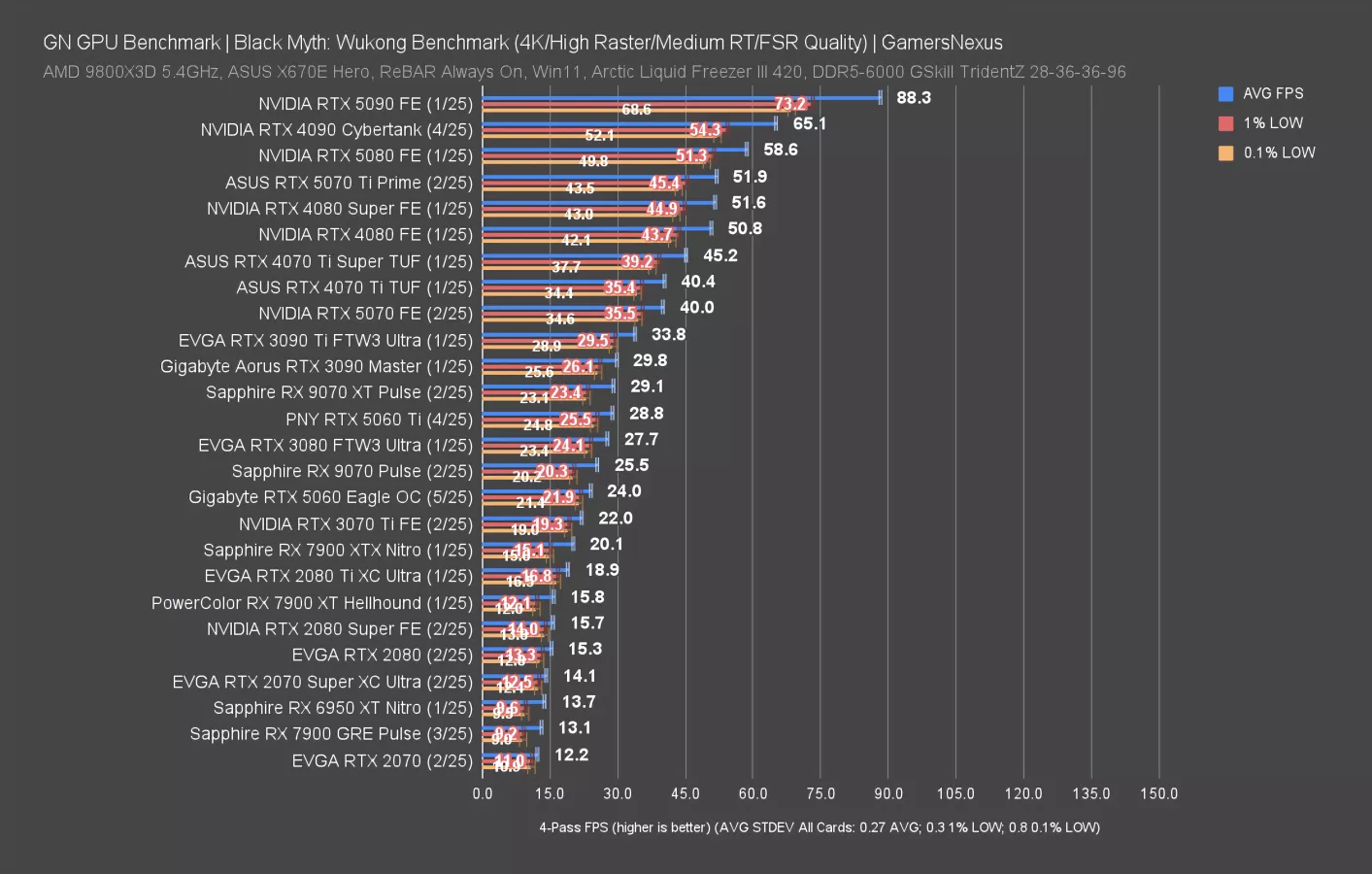
In Black Myth at 4K with upscaling, the RTX 5060 ran at 24 FPS AVG and roughly tied the 9070 -- which performs awfully in this specific game with RT -- and the 3070 Ti. This is unplayable, and limited VRAM will get the best of it as play time extends as well, so let’s move on.
Ray Tracing - Black Myth: Wukong 1440p

At 1440p with upscaling, the RTX 5060 ran at 45 FPS AVG and again roughly tied the 9070, which isn’t good for the 9070. This game continues to be an impossible challenge for AMD. The 5060 Ti leads the 5060 by 20% here, similar to what we saw in rasterized scenarios.
Ray Tracing - Black Myth: Wukong 1080p
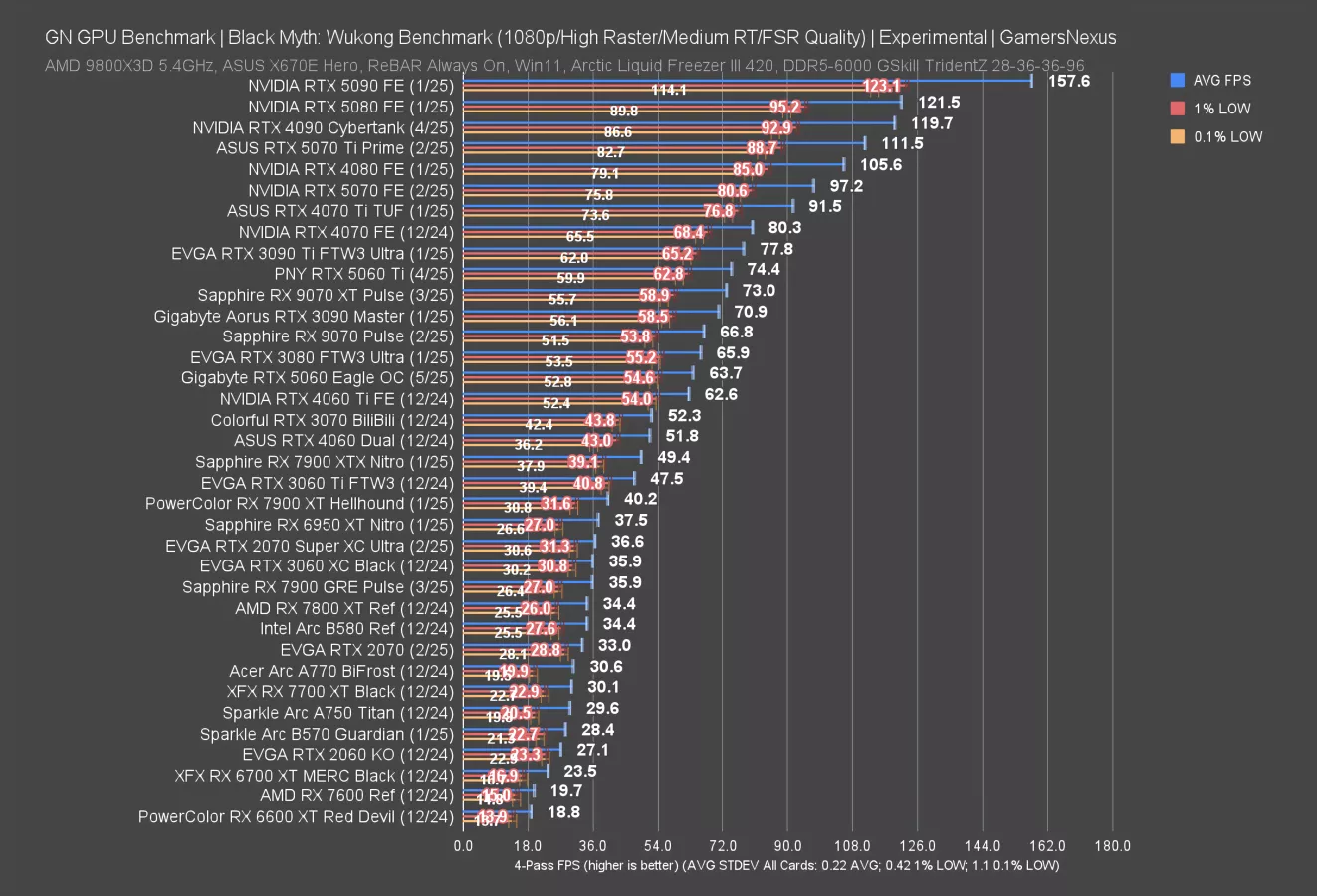
At 1080p with upscaling, the 5060 now runs at 64 FPS AVG and is about equal to the 4060 Ti 16GB and 3080. The 4060 also appears on this chart at 52 FPS AVG, with the 5060 ahead by 23%. The 3060 Ti’s 48 FPS AVG means the 5060 improves on the Ampere card by 34%, or 77% ahead of the RTX 3060’s 36 FPS AVG. The B580 isn’t particularly competitive here, either, down at 34 FPS AVG and around the RTX 2070.
Dragon's Dogma Ray Tracing Benchmarks
Ray Tracing - Dragon’s Dogma 2 4K
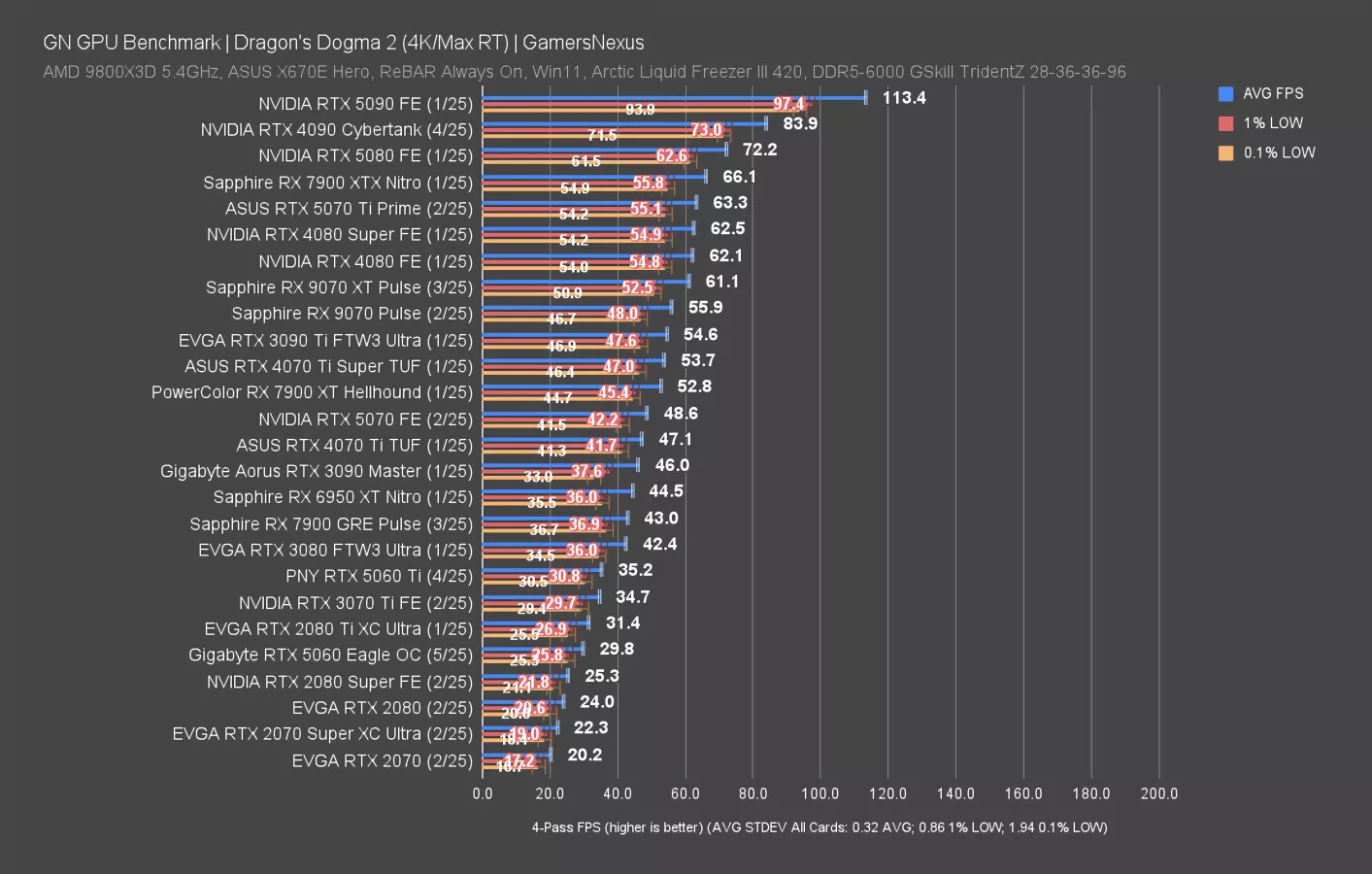
Dragon’s Dogma 2 with ray tracing and tested at 4K has the RTX 5060 at just 30 FPS AVG, which we all know humans definitely can’t see faster than, and so this card is basically perfect. Just like Jensen said.
The 5060 Ti leads the 5060 by 18% here, but let’s move to 1440p for more results.
Ray Tracing - Dragon’s Dogma 2 1440p
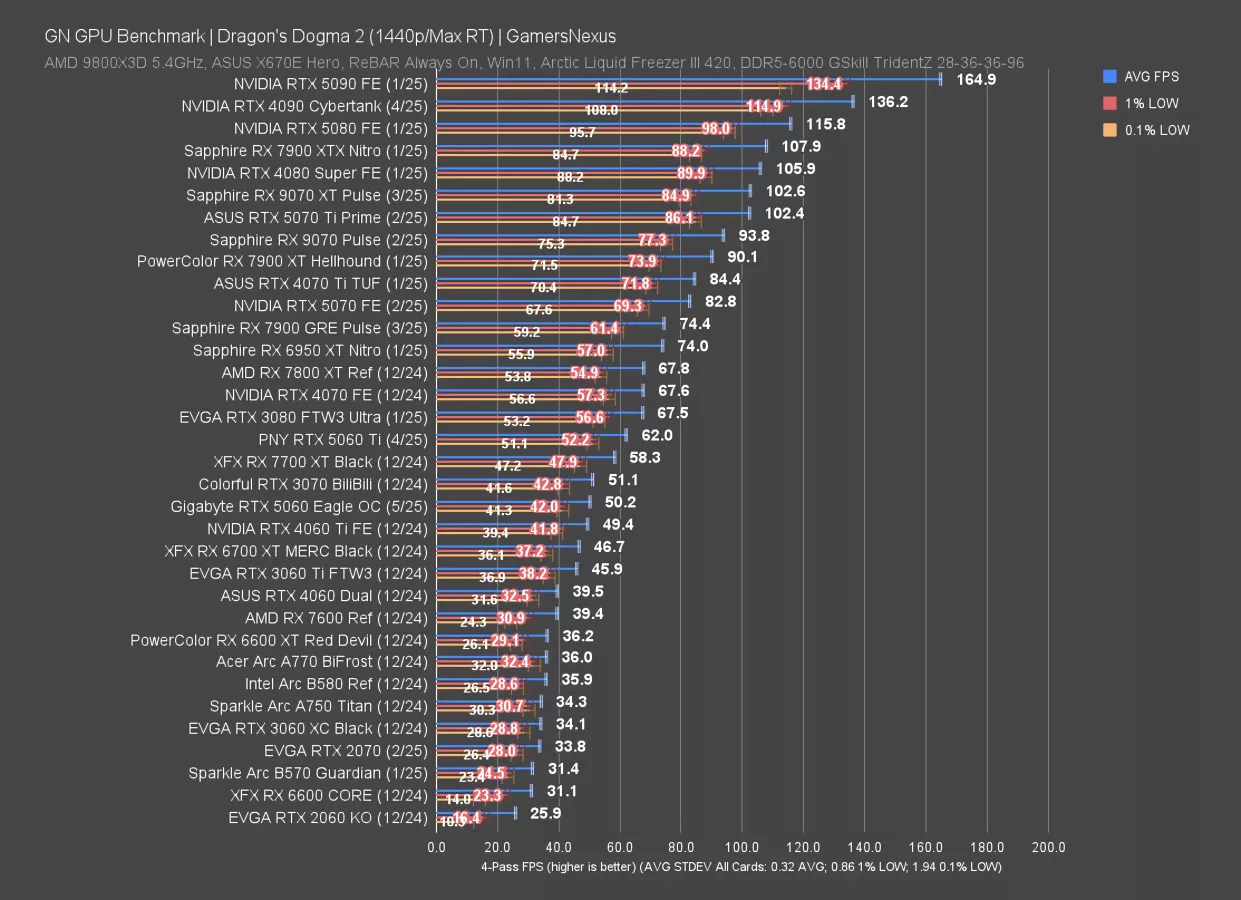
At 1440p with ray tracing, the RTX 5060’s 50 FPS AVG tied it with the 4060 Ti 16GB and 3070. The 7700 XT seems like a particularly useful landmark for future benchmarks and reviews.
As for generational improvement, the 5060 posts a 27% improvement over the 4060, which was previously bested by the 3060 Ti, and a 47% improvement over the 3060 non-Ti.
Ray Tracing - Dragon’s Dogma 2 1080p
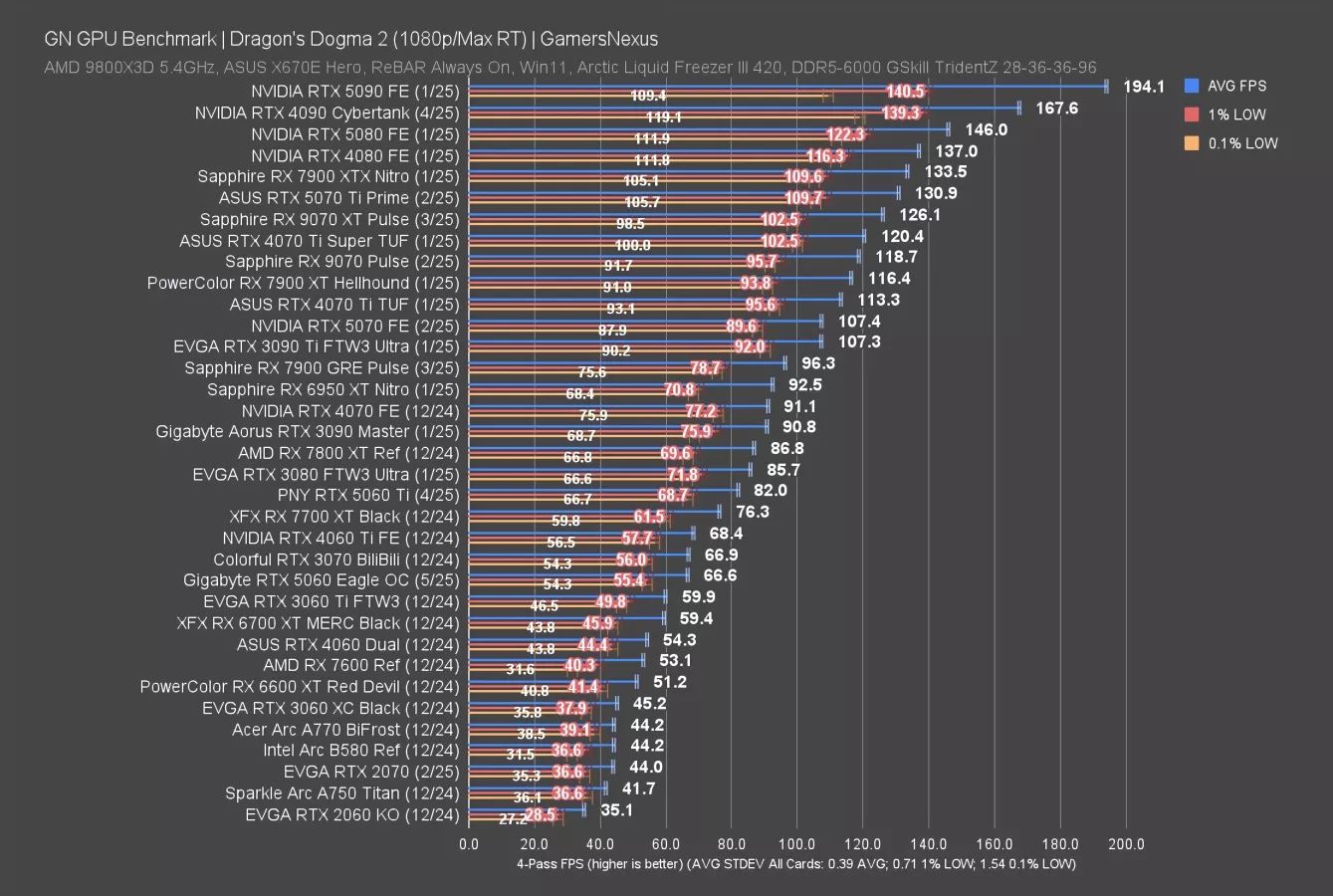
1080p brings the 5060 up to 67 FPS AVG when tested with ray tracing. This has its performance experientially the same as the results for the 4060 Ti and RTX 3070, with the 3060 Ti not that different in experience at 60 FPS AVG. The 6700 XT is in the same boat as the 3060 Ti. Over last gen, the 5060 improves by 23% by name only. That’s ignoring NVIDIA’s name games it plays, where a 5060 is basically a modern 30 or 50-class GPU at best.
Dying Light Ray Tracing Benchmarks
Ray Tracing - Dying Light 2 1440p
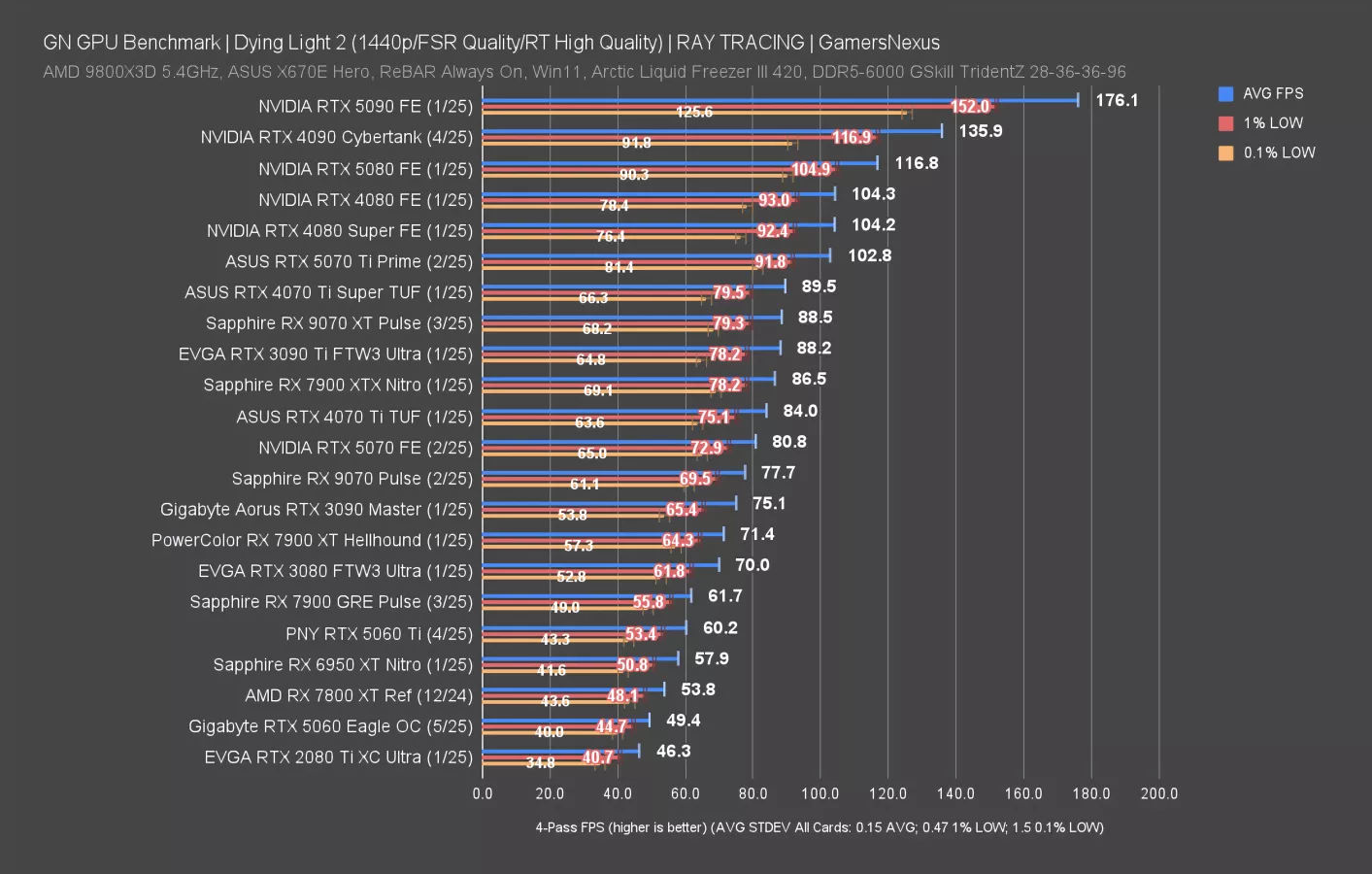
Dying Light 2 with ray tracing and at 1440p upscaled is next. In this one, the RTX 5060 ran at 49 FPS AVG, with the 5060 Ti ahead by 22%. AMD does comparatively better in this one versus its Black Myth performance earlier, but we need to go down to 1080p for more cards.
Ray Tracing - Dying Light 2 1080p
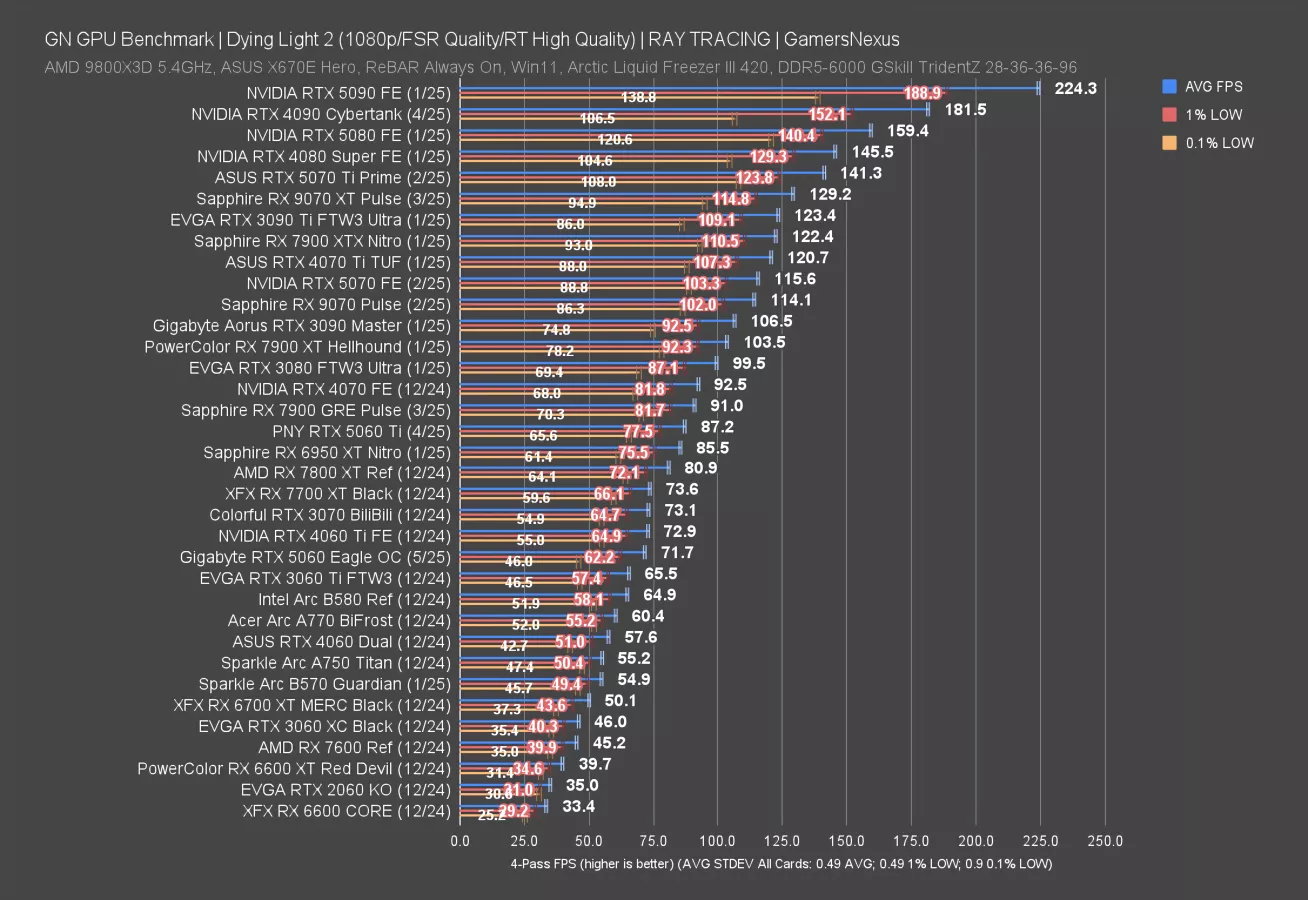
At 1080p upscaled, the 5060’s 72 FPS AVG has it about the same as the 4060 Ti 16GB, but the 4060 Ti had superior 0.1% lows in this set of test passes. The 5060 is about 9-10% better than the B580 and 3060 Ti, so Intel is doing better here than in some other benchmarks. Its lows are also more consistent than some of its previous performances.
Against the 4060, the 5060 is 25% improved, or 56% improved over the 3060. AMD’s direct competitor will be on our chart within days, so we’ll check back for that. For now, the 7800 XT would be a reasonable comparison and outperforms the 5060 by 13%.
Resident Evil 4 Ray Tracing Benchmarks
Ray Tracing - Resident Evil 4 4K
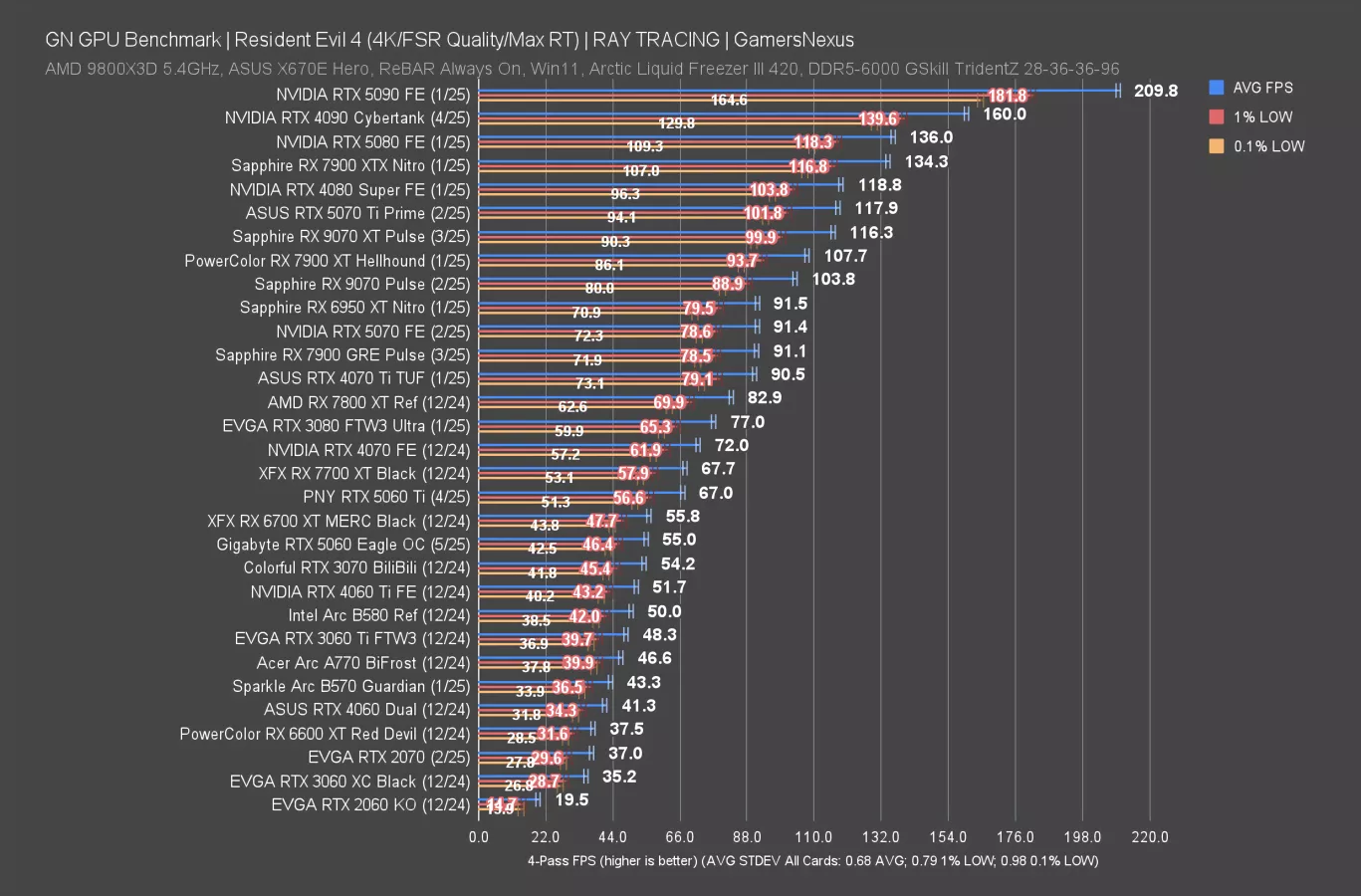
Resident Evil 4 at 4K is up now, this time ray traced and with upscaling. The RTX 5060 ran at 55 FPS AVG, again roughly tying it with a 3070 and 6700 XT. The 5060 Ti is again around 22% better than the 5060 in average FPS here, with lows improved proportionally.
Intel’s B580 remains more competitive than NVIDIA probably wants it to be, but it still has some ground to gain to directly compete with NVIDIA when assuming price parity. It’s getting there, though. AMD’s direct competitor will be on the charts soon enough.
Ray Tracing - Resident Evil 4 1440p
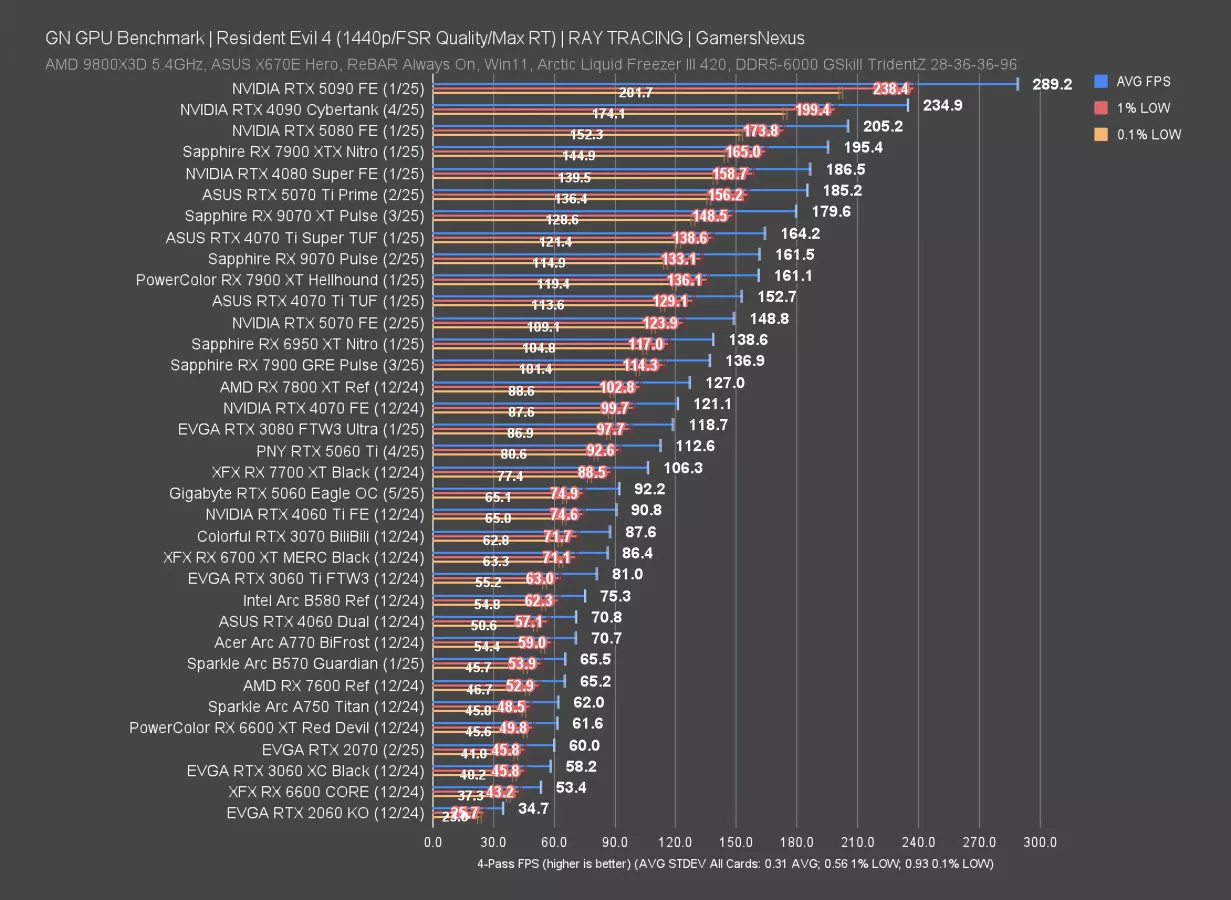
At 1440p with upscaling and RT, the RTX 5060’s 92 FPS AVG has it about equal to the 4060 Ti 16GB and slightly ahead of the RTX 3070 and RX 6700 XT. The 5060 Ti leads by 22% again. Intel’s B580 is still back far enough that NVIDIA has some breathing room as long as Intel doesn’t make a big generational gain with Celestial, and also assuming its price remains competitive.
Against older hardware, the 5060 improves upon the 3060 Ti’s 81 FPS AVG by a little over 10 FPS, with the improvement on the 4060 at about 30%.
RTX 5060 Conclusion

Should you buy the RTX 5060 right now? No. You should also look at the 9060 XT, which offers 16GB and 8GB variants as well. Looking at the 8GB cards from both AMD and NVIDIA, we’re going to have the same complaints, which include running into limitations in at least some scenarios. At this point, 8GB cards at this class are getting ridiculous.
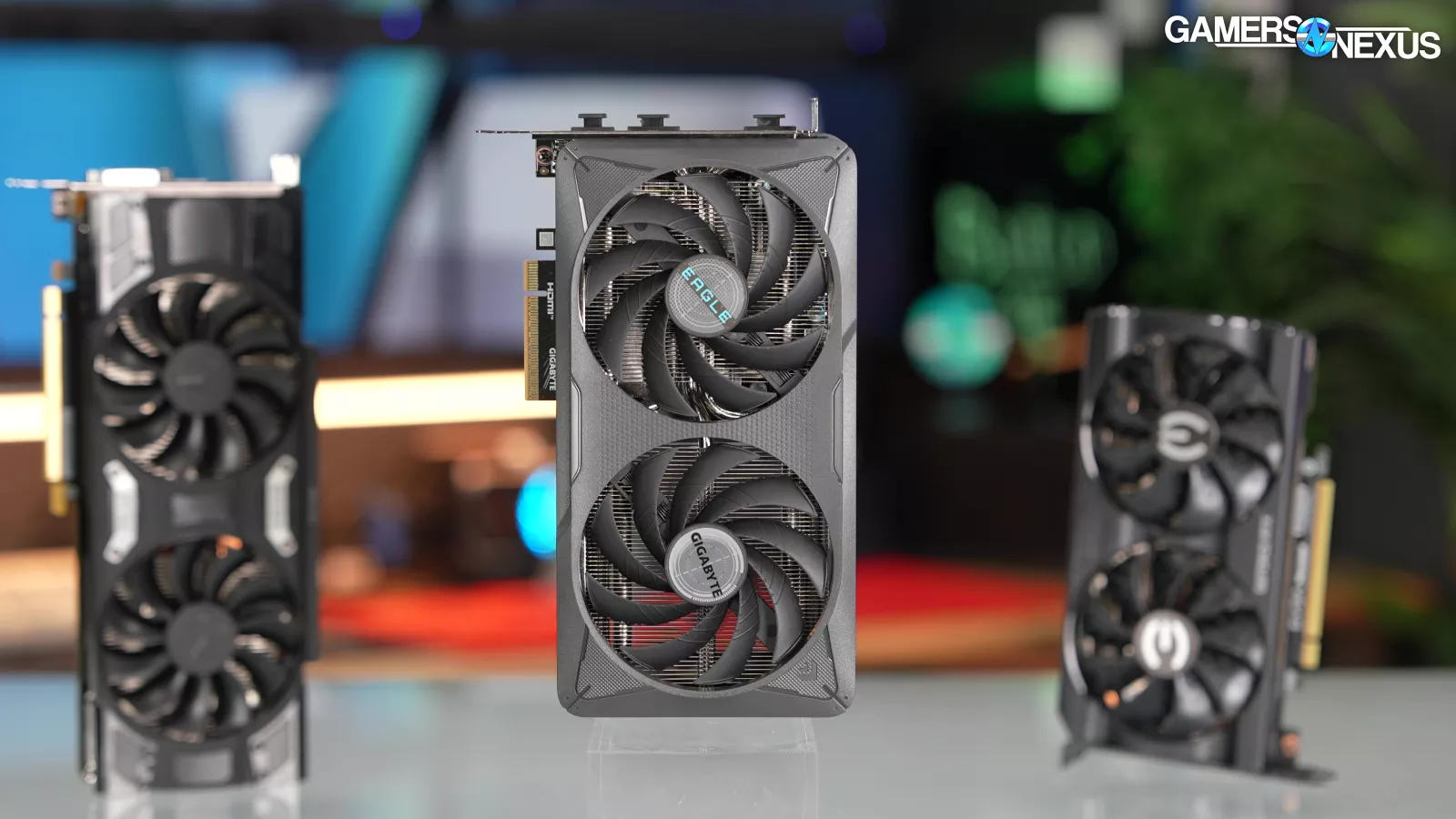
We believe that NVIDIA is damaging the PC gaming hobby and PC building. The company is doing a lot of shady sh*t right now and is acting in what we believe is an anti-consumer way.